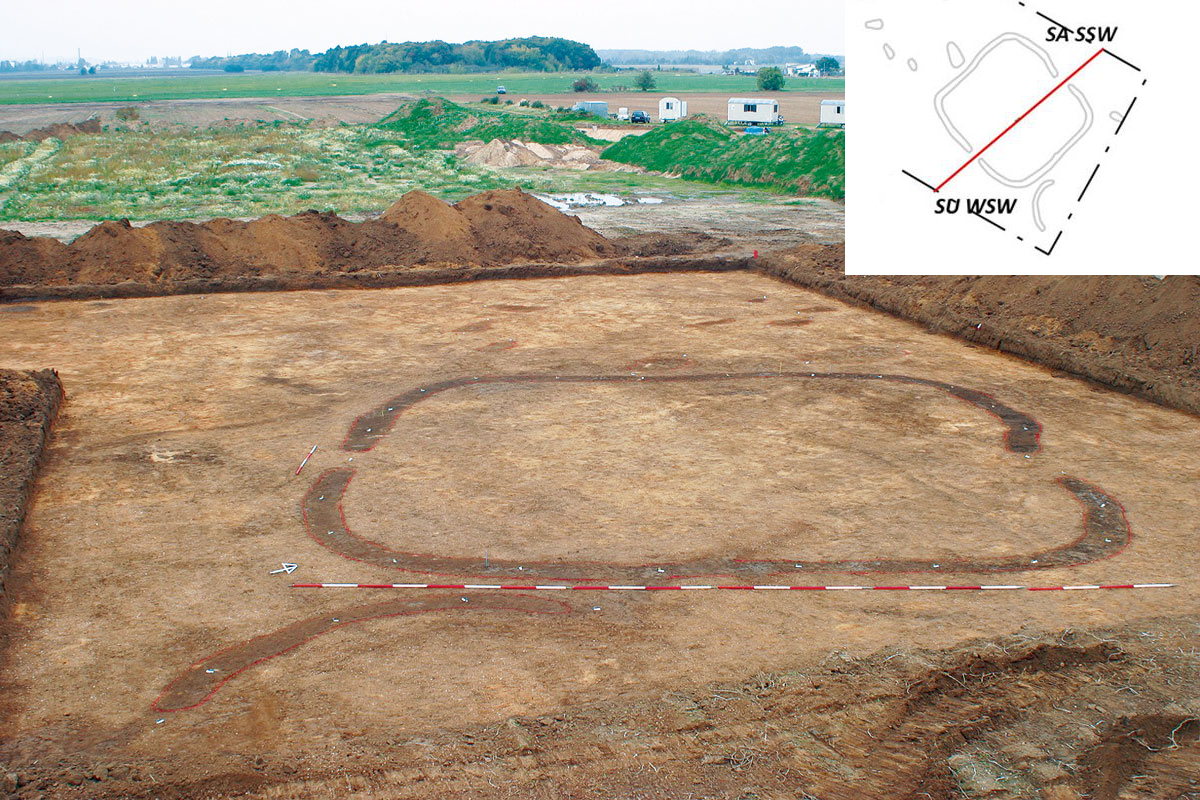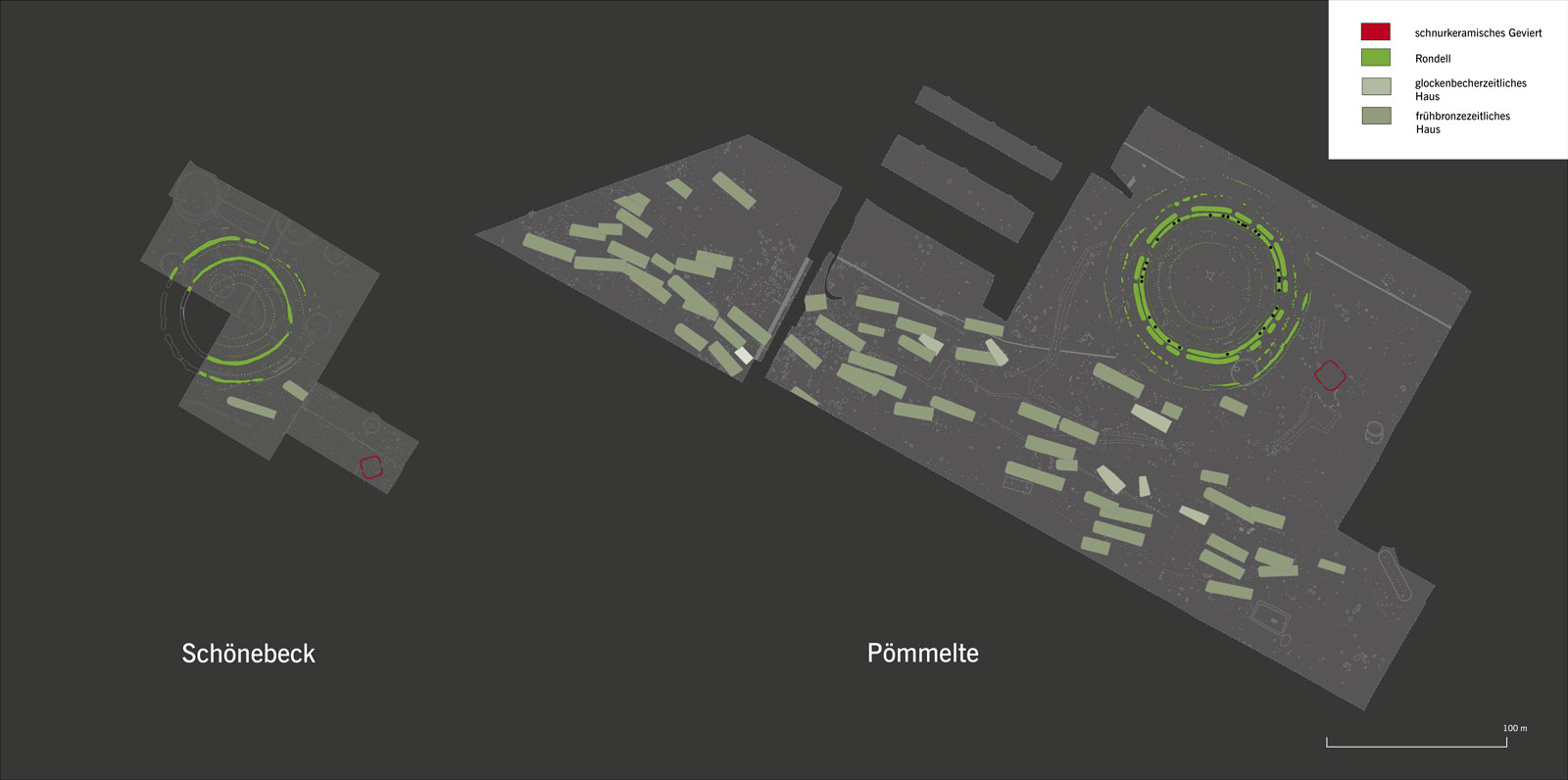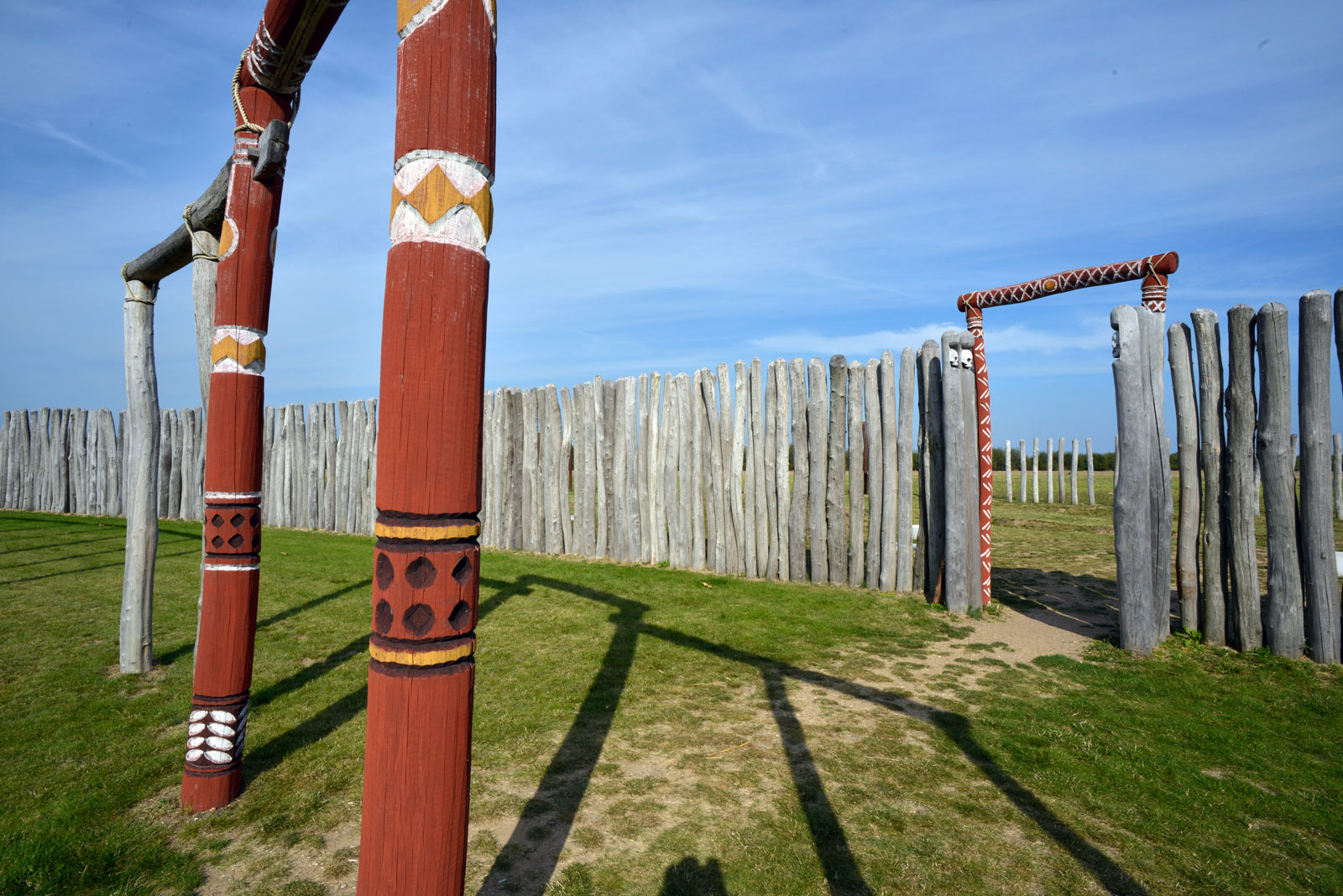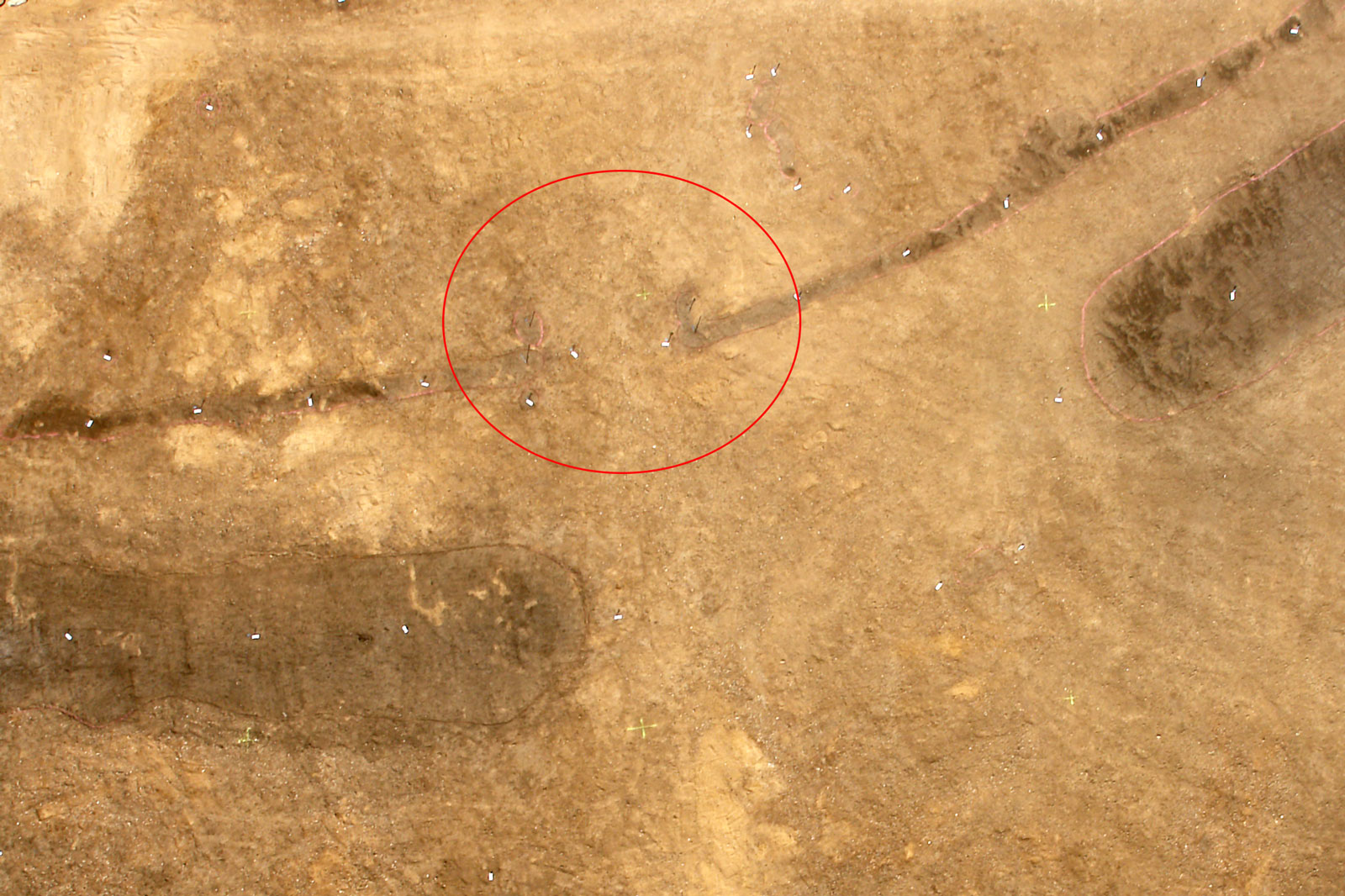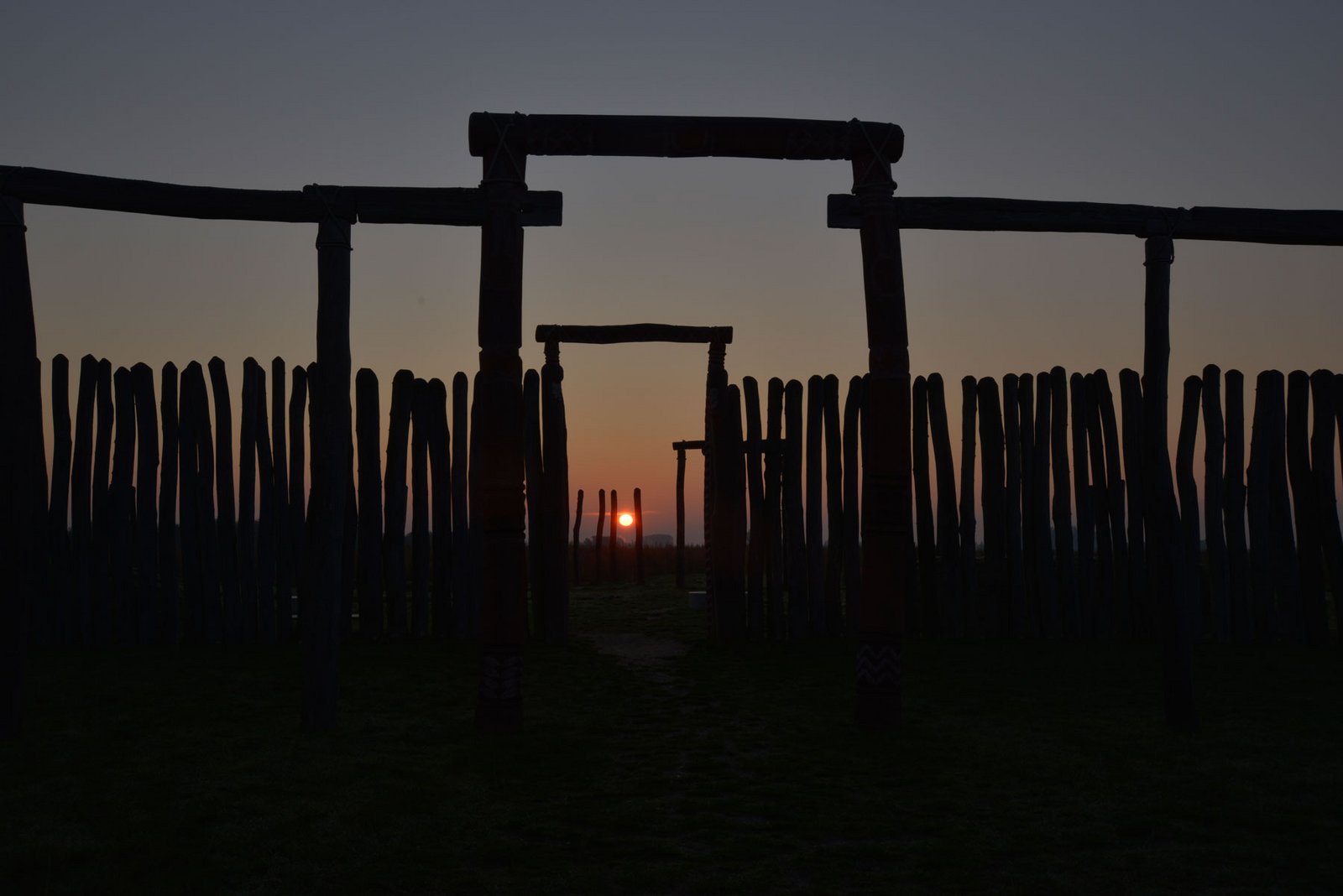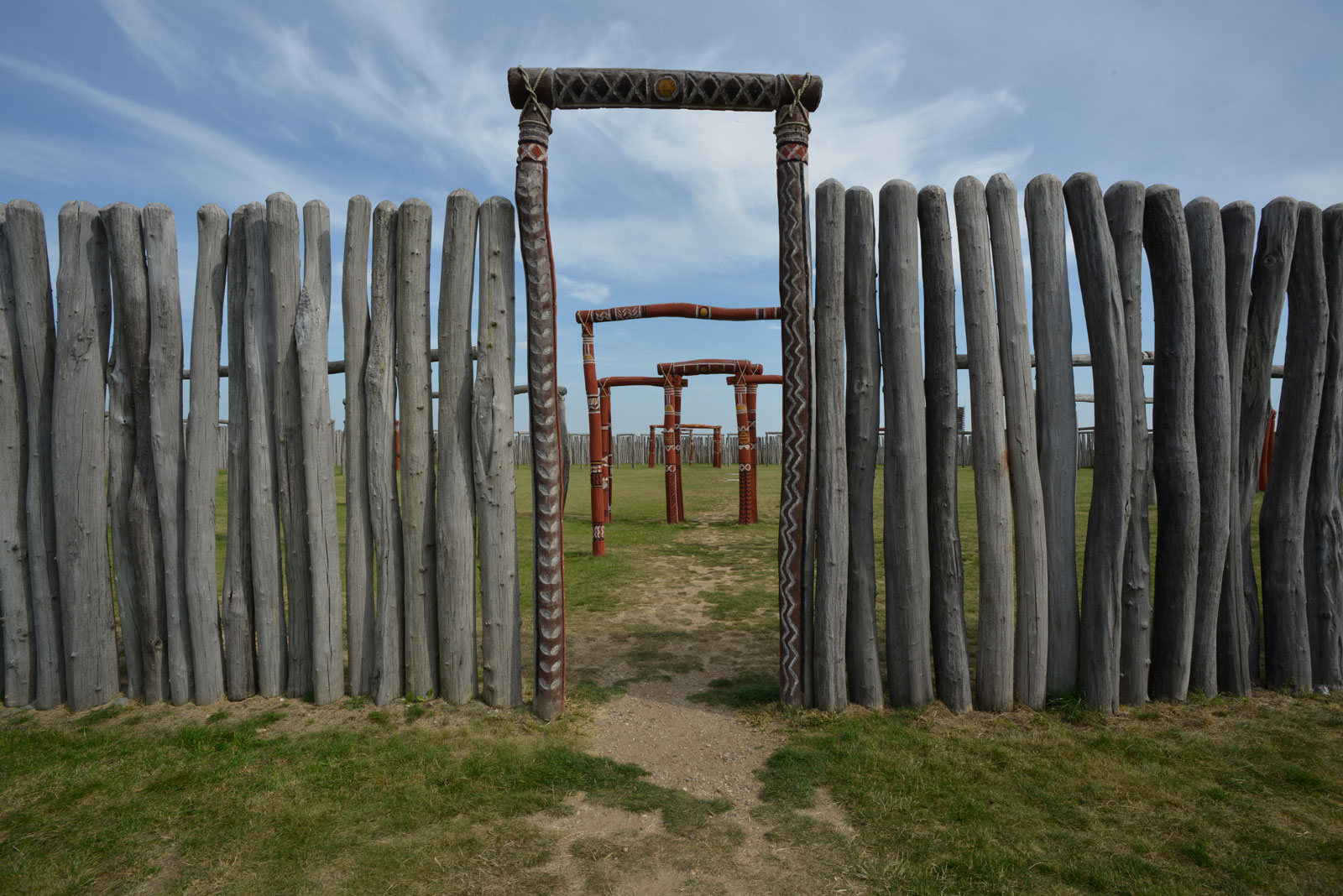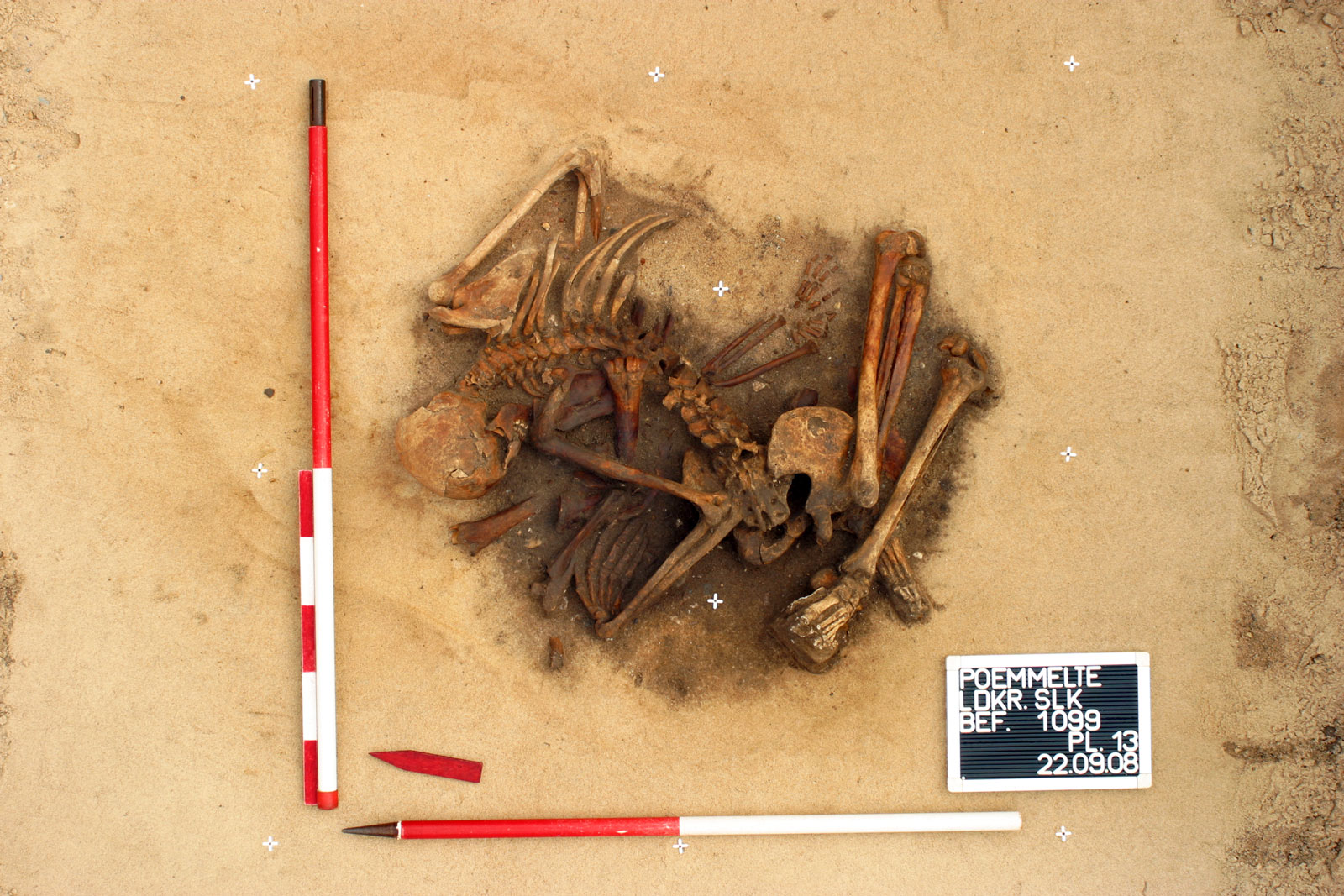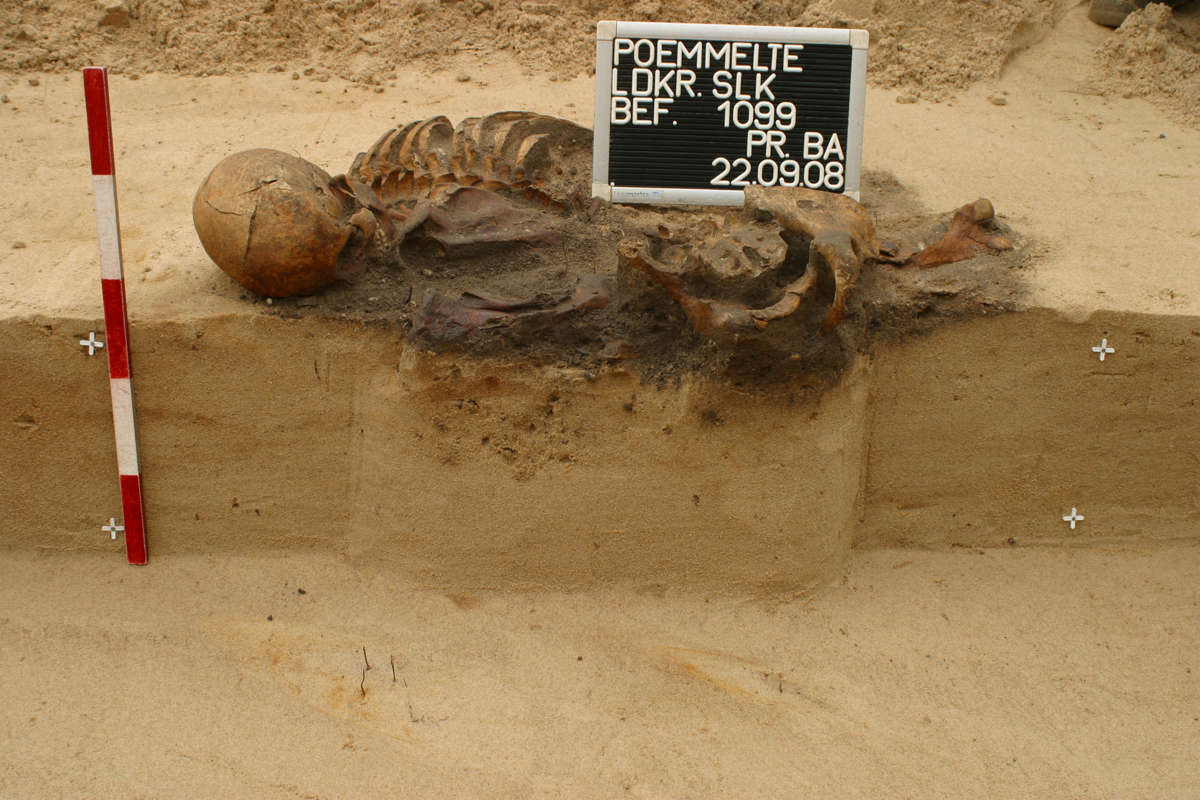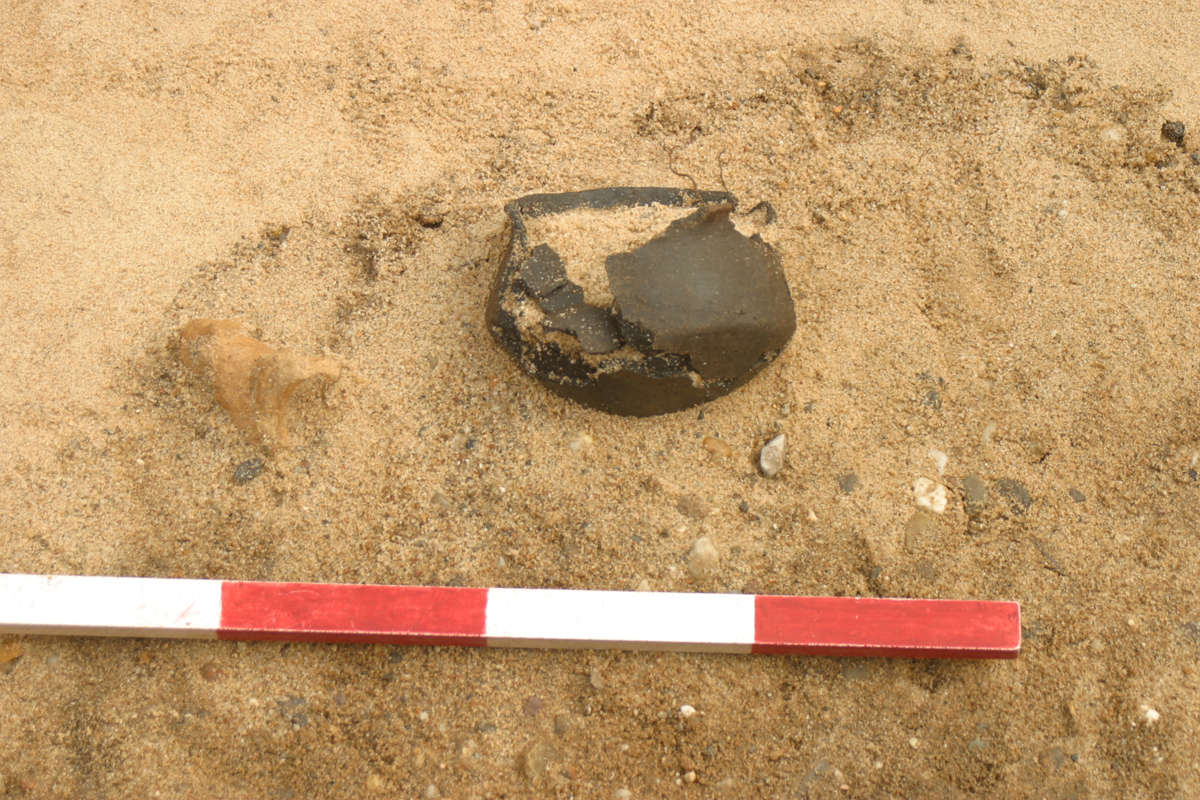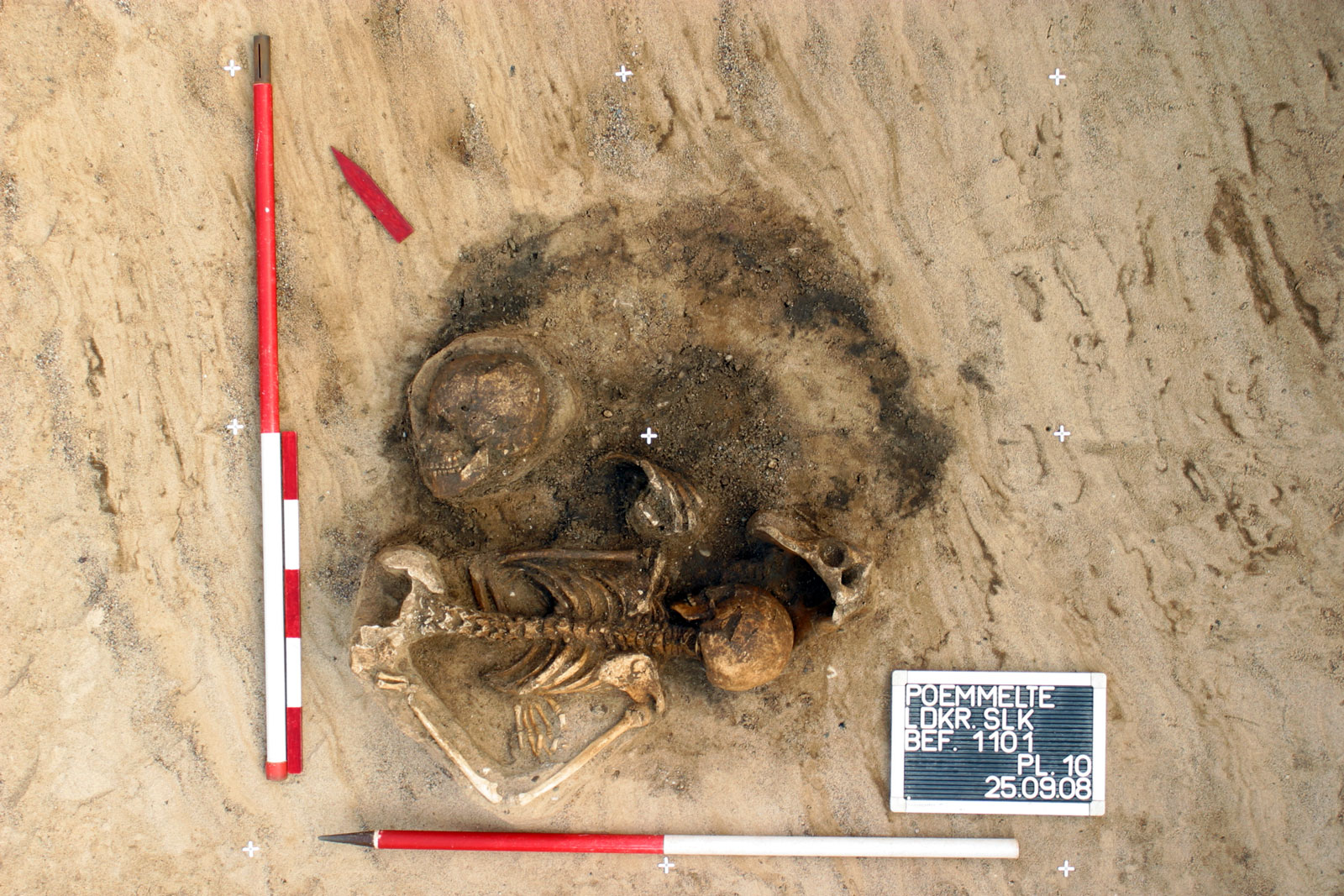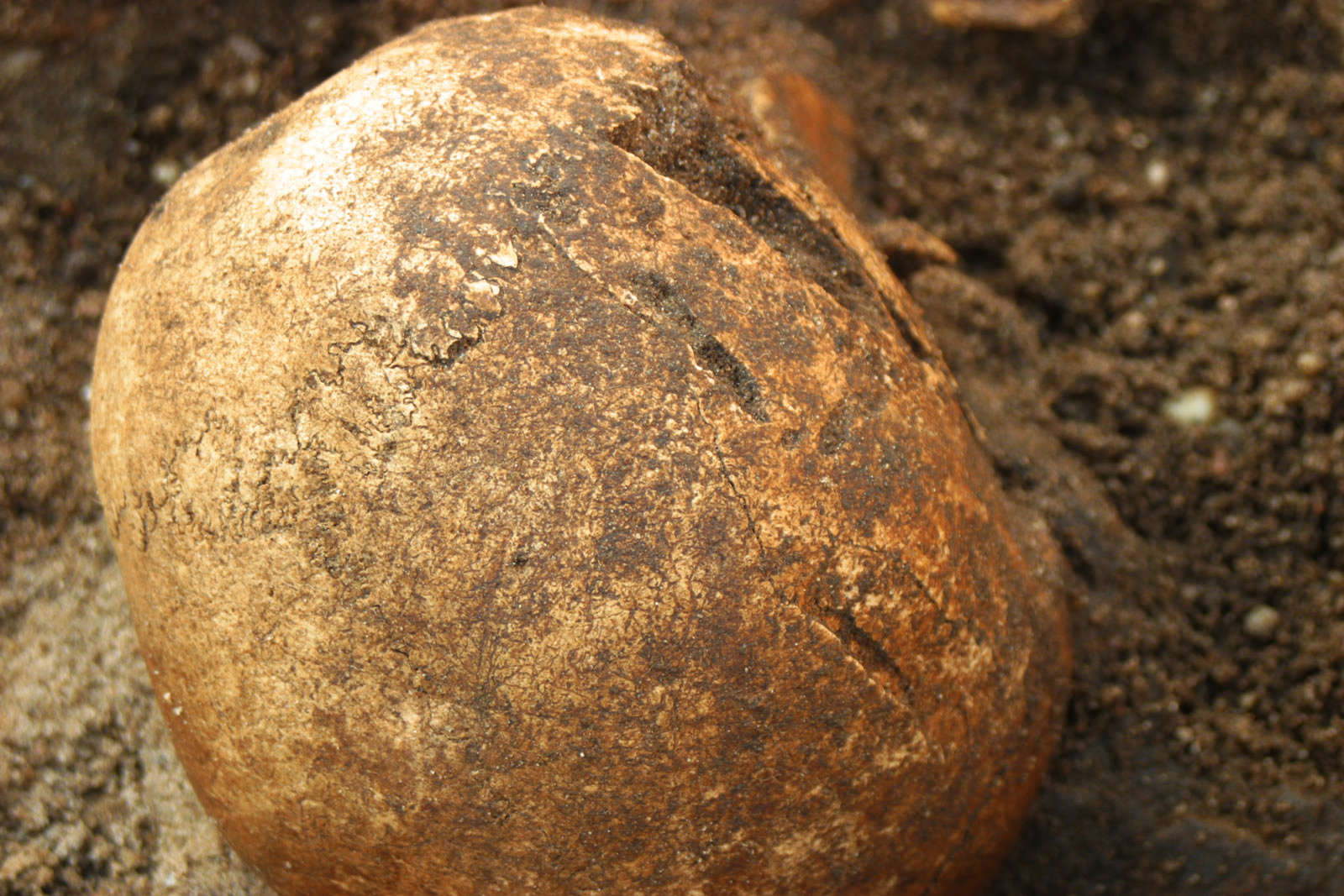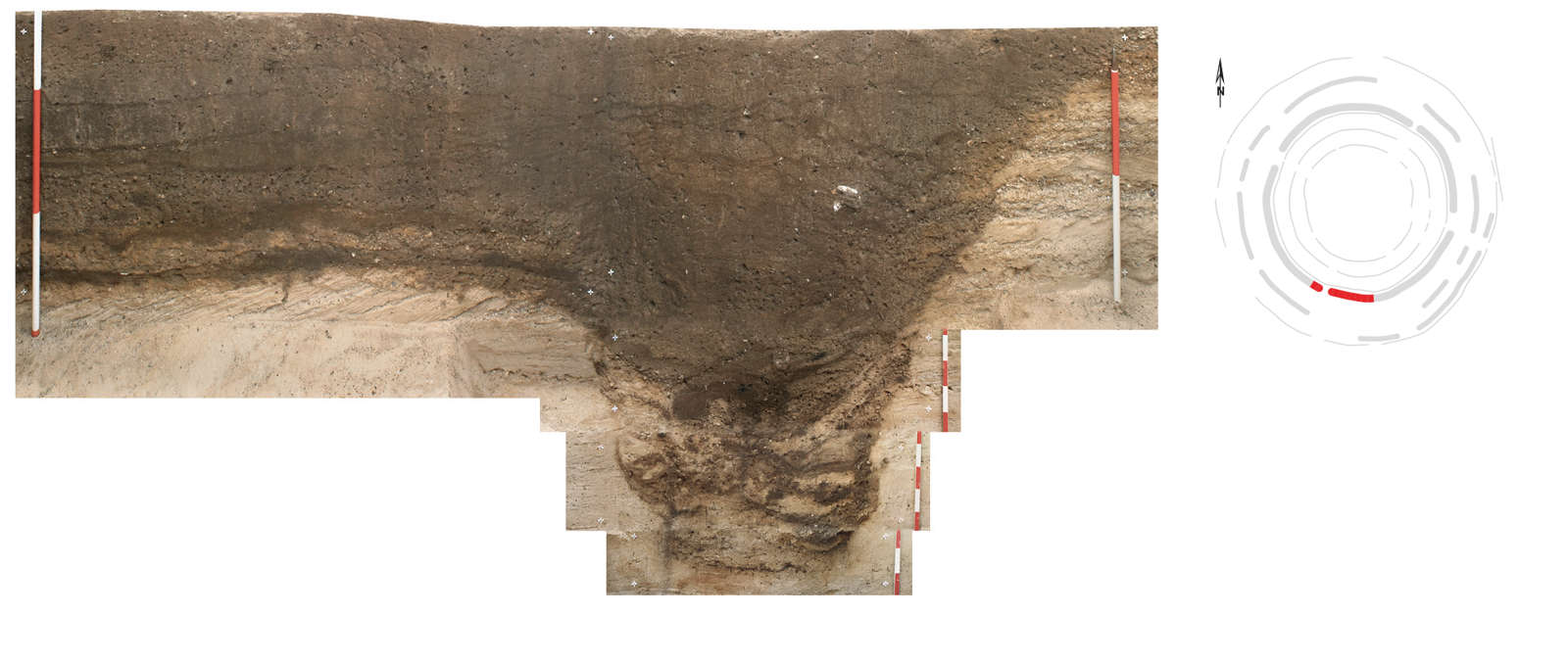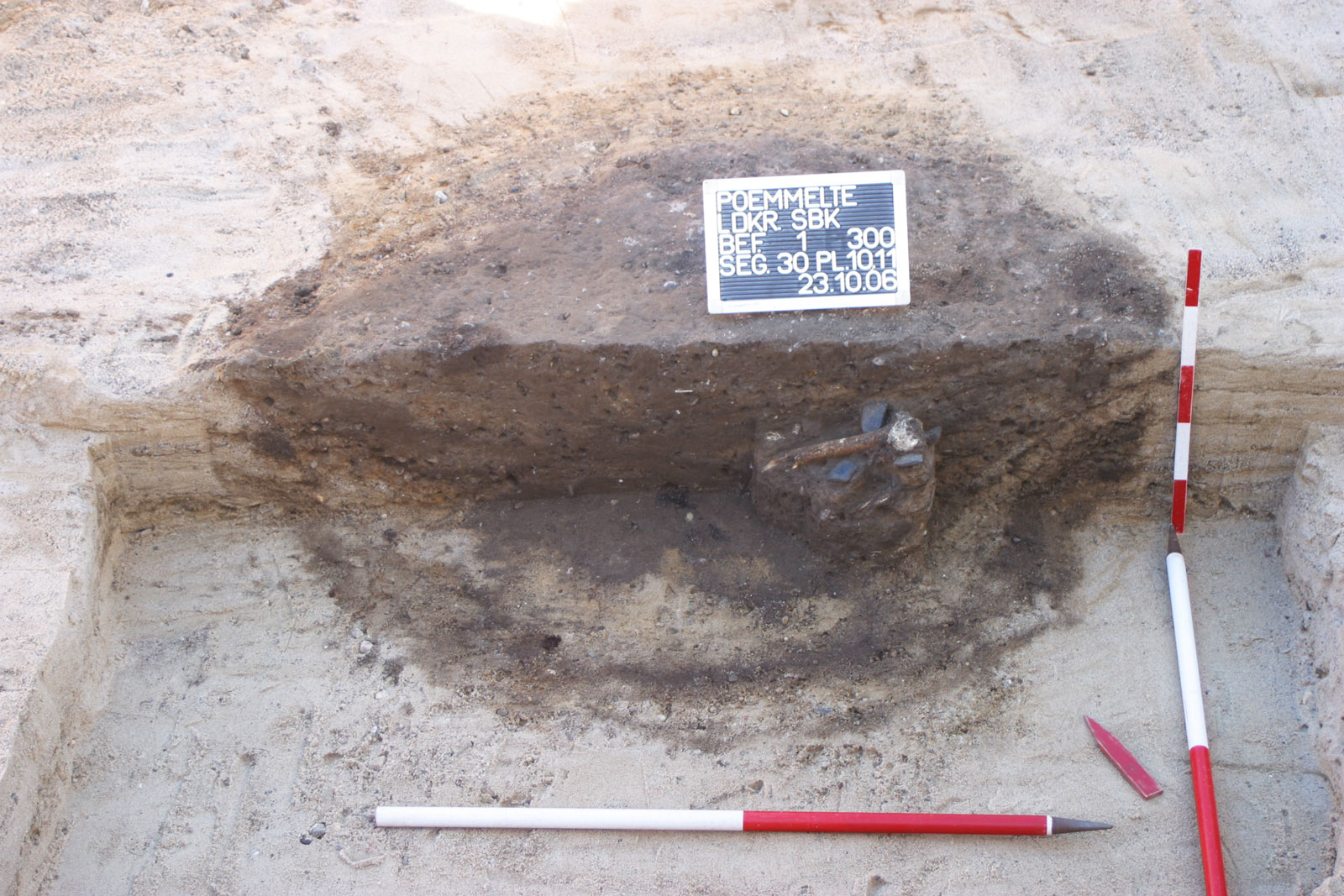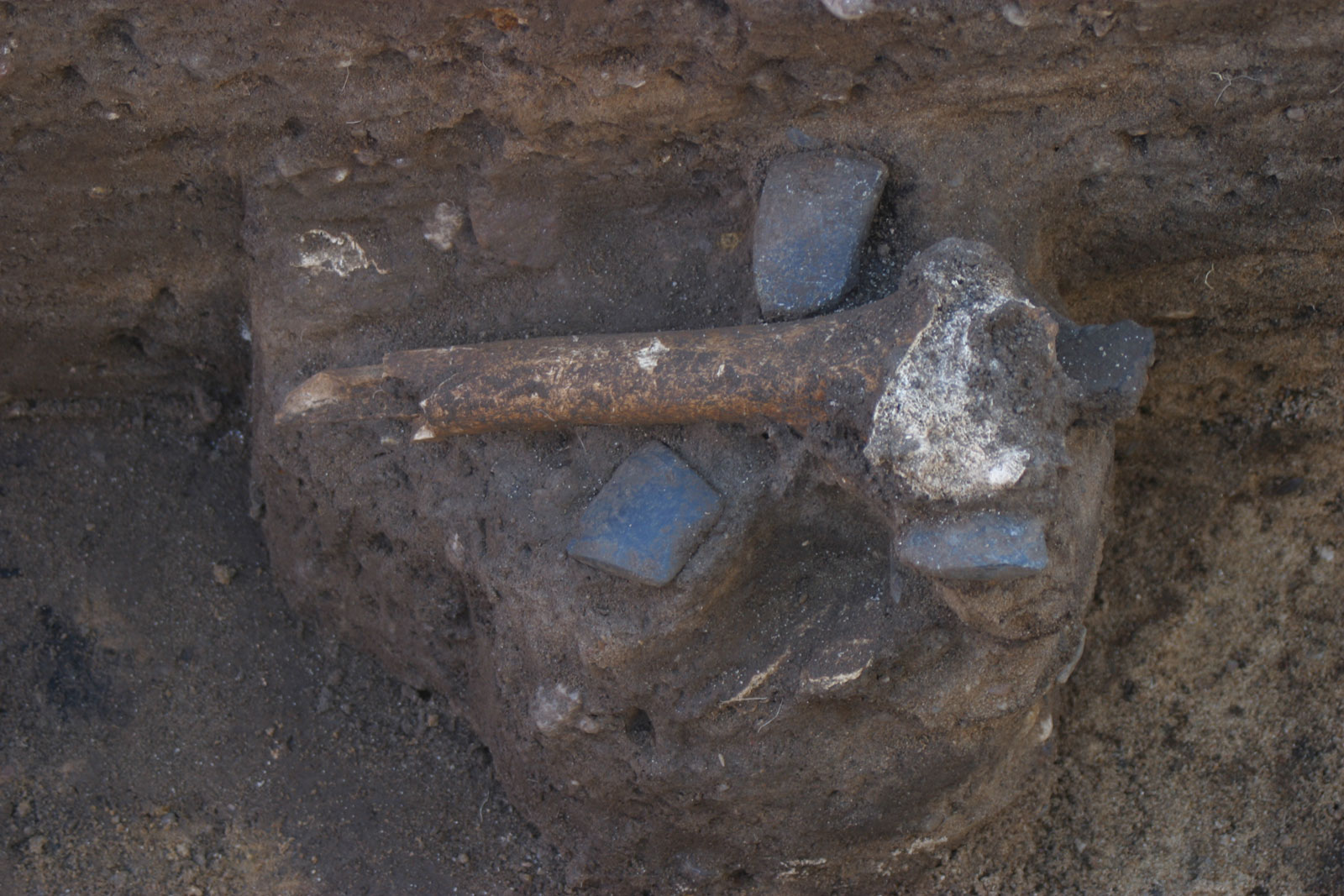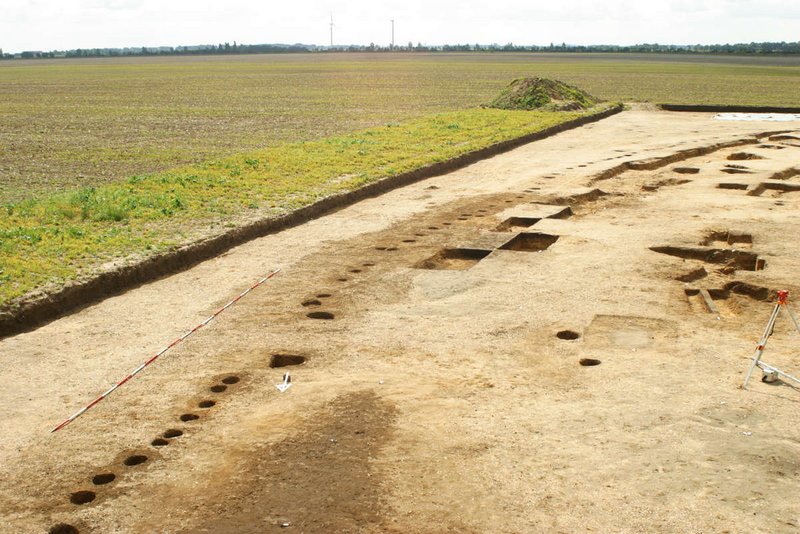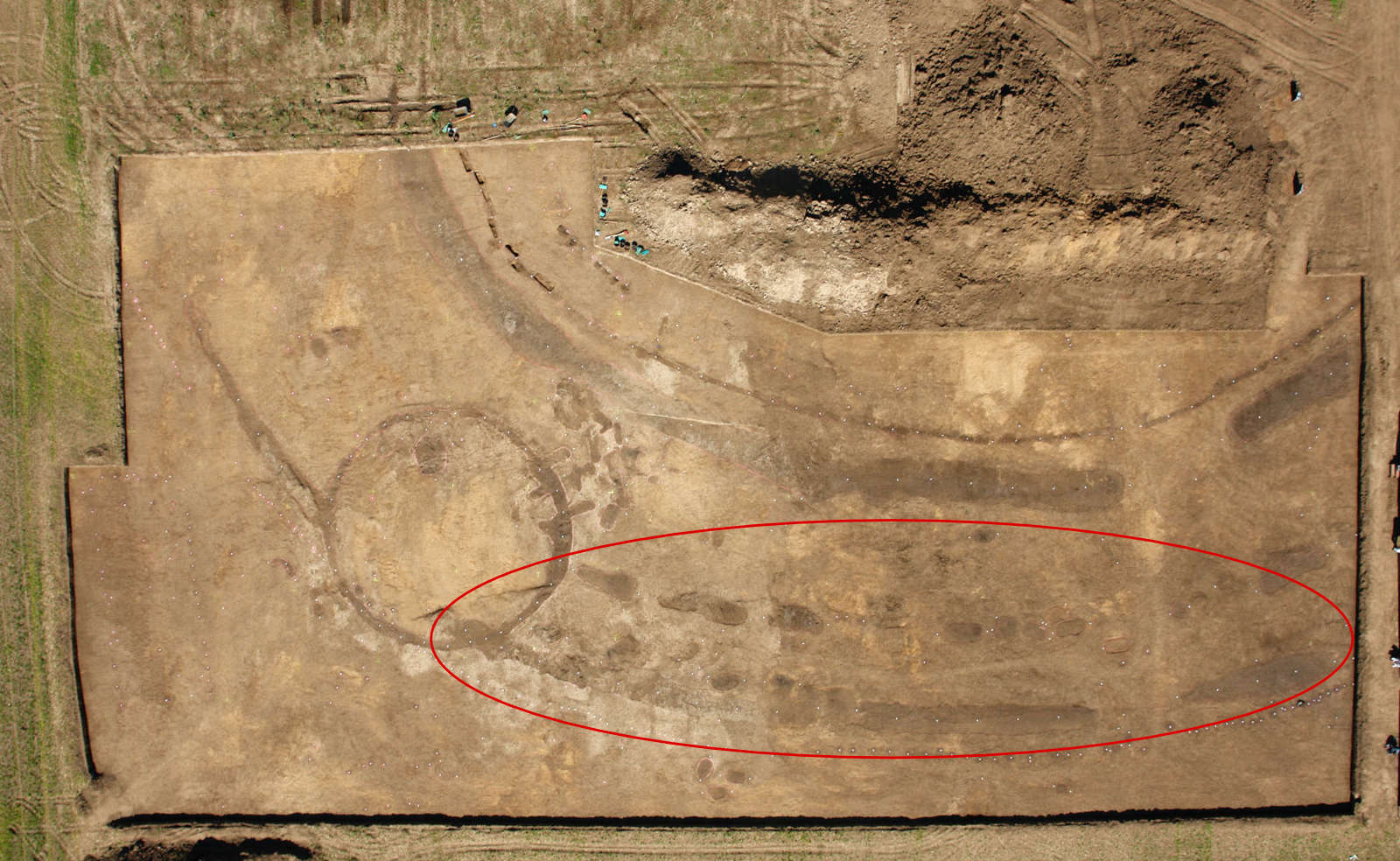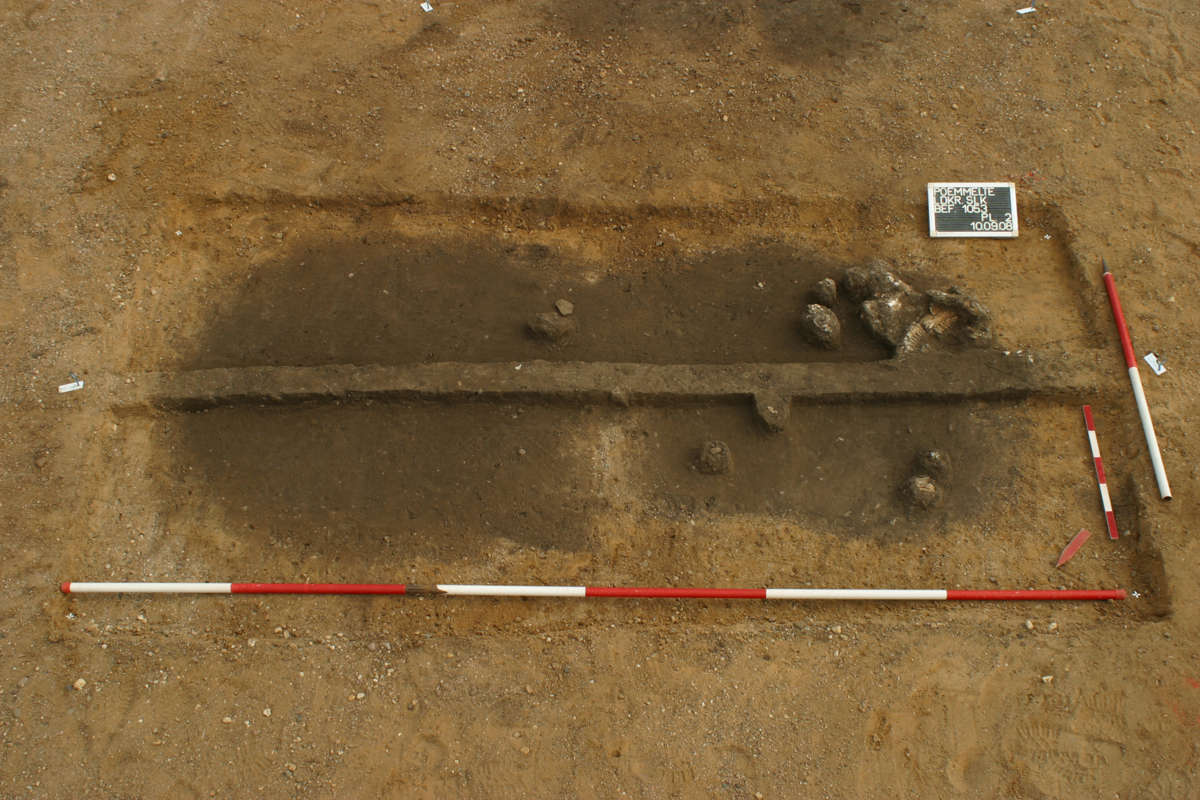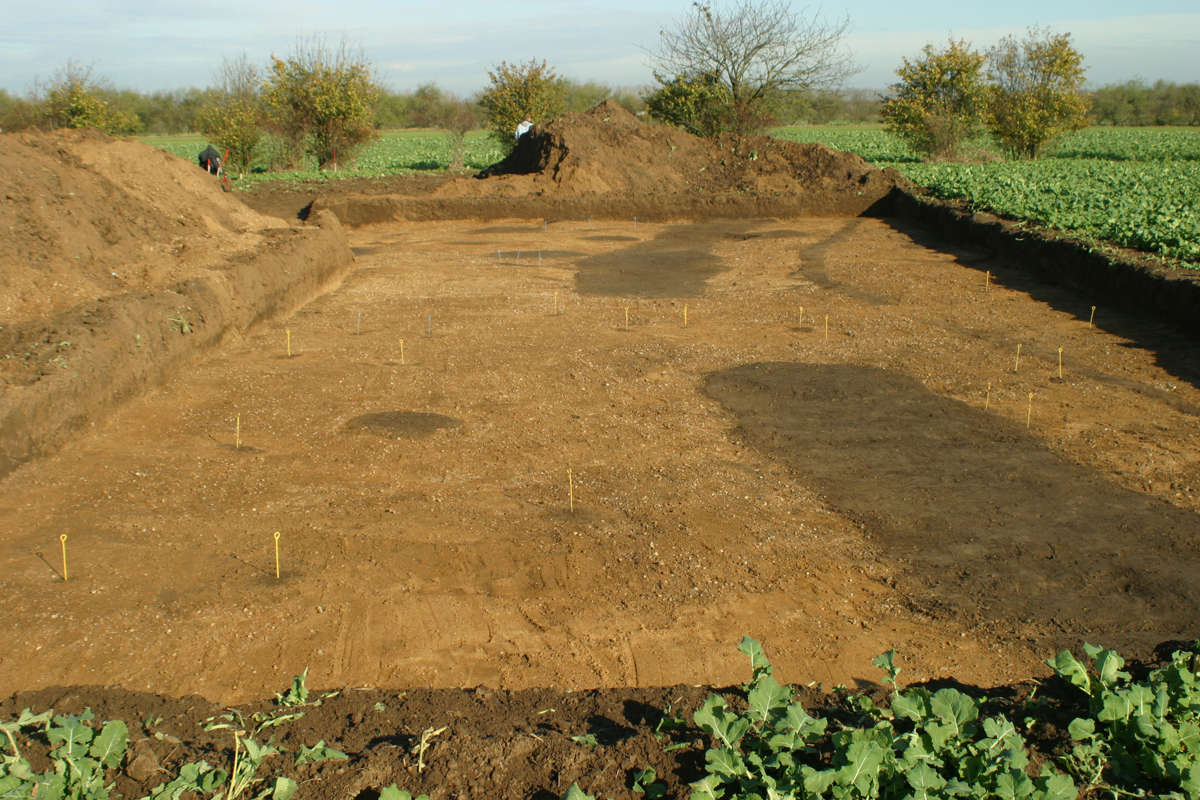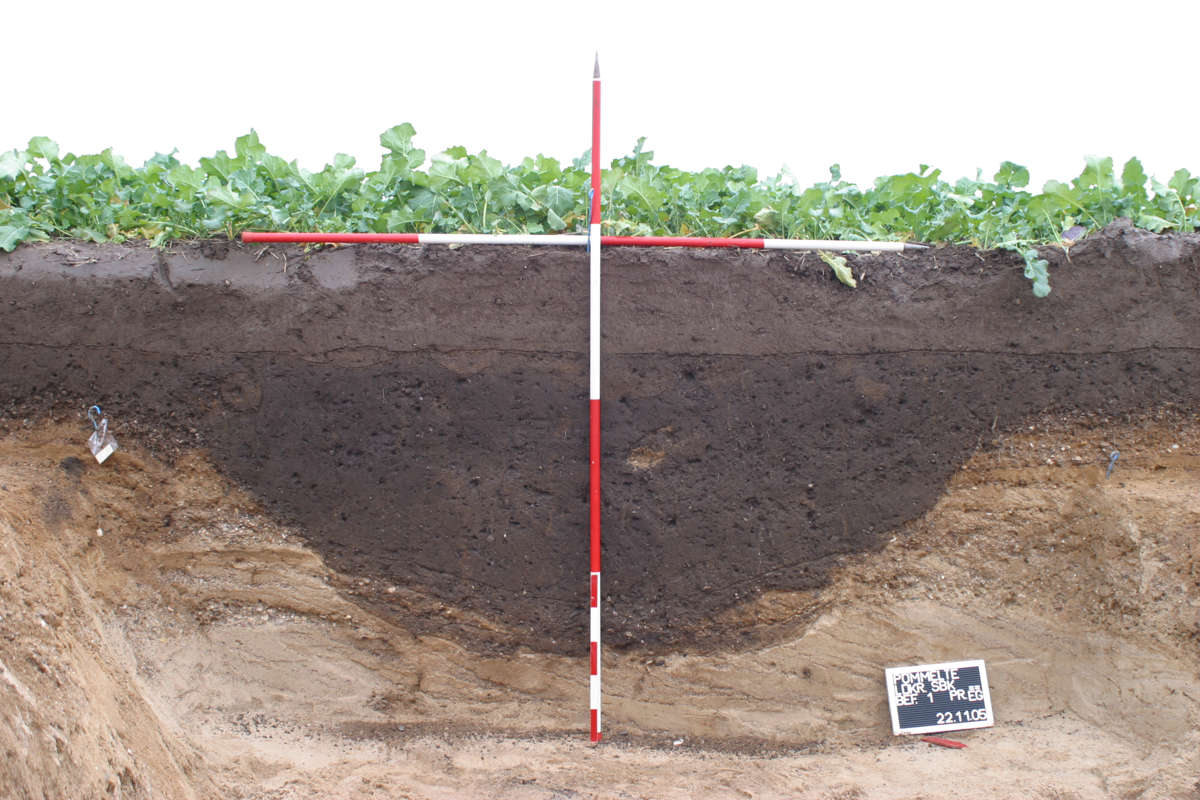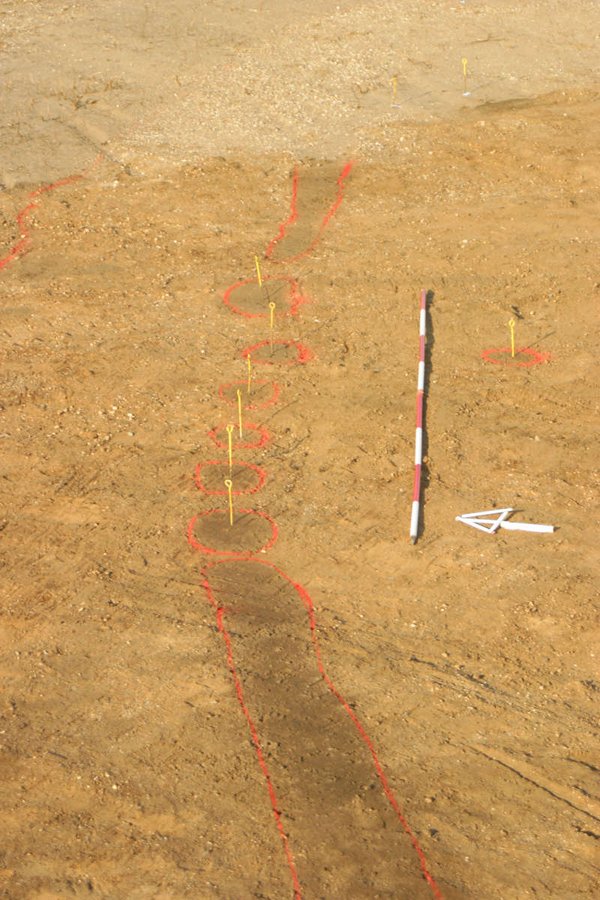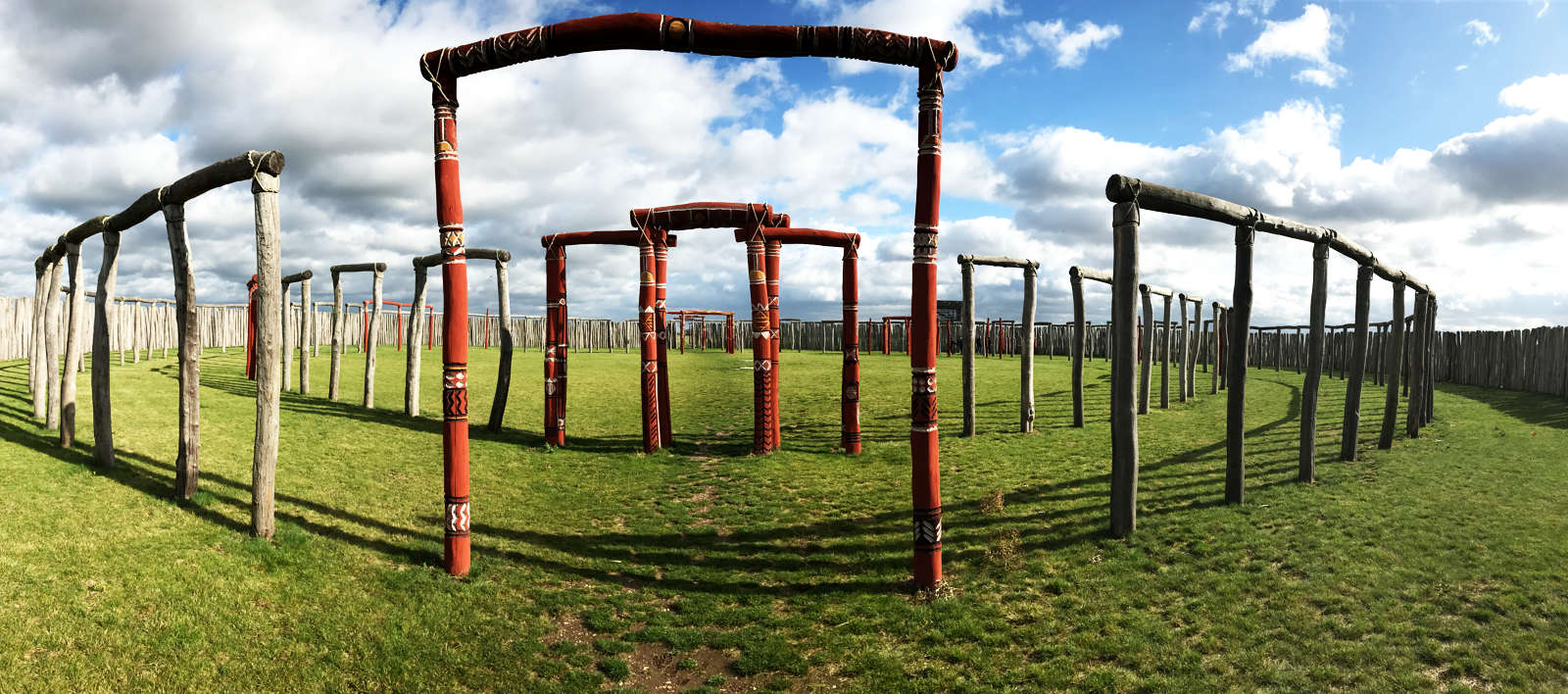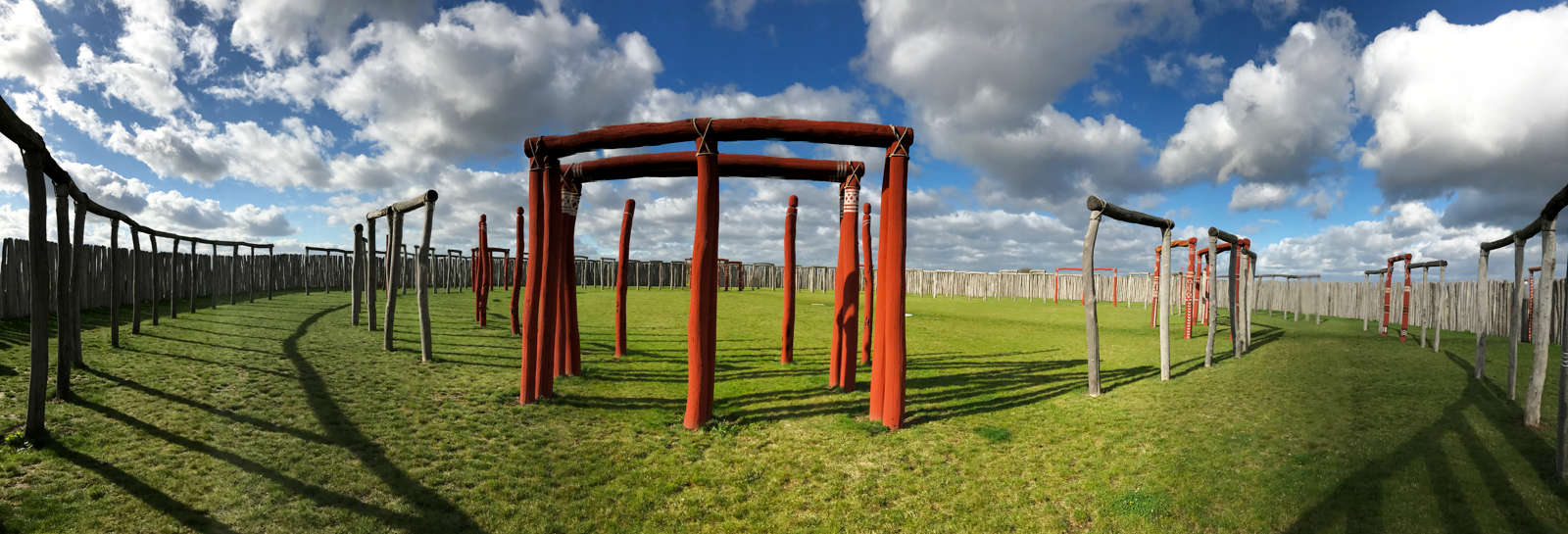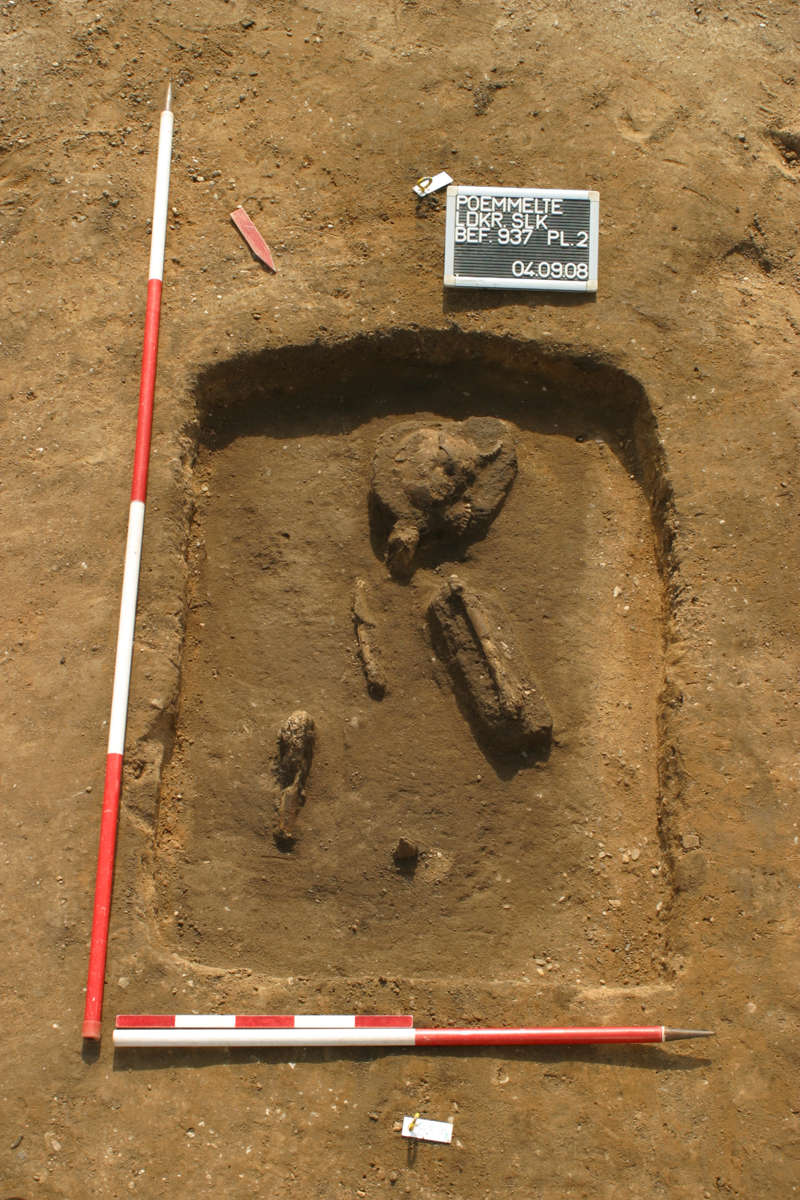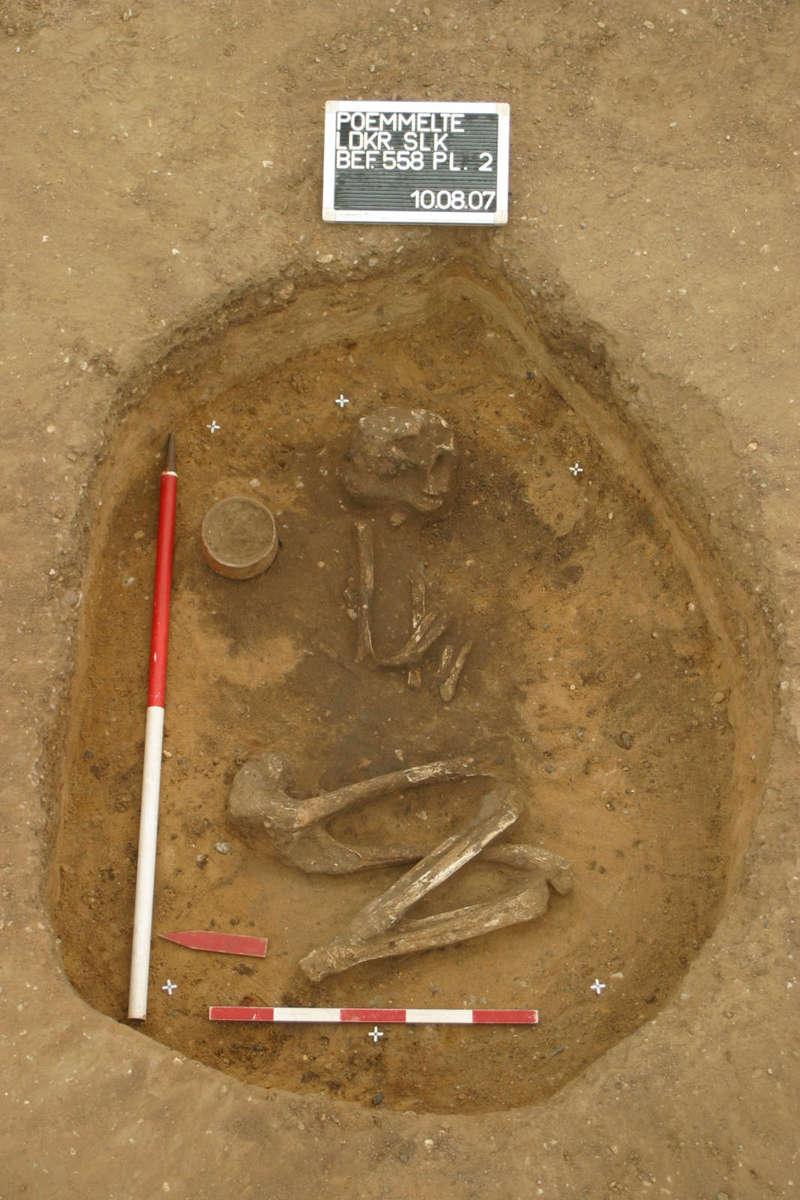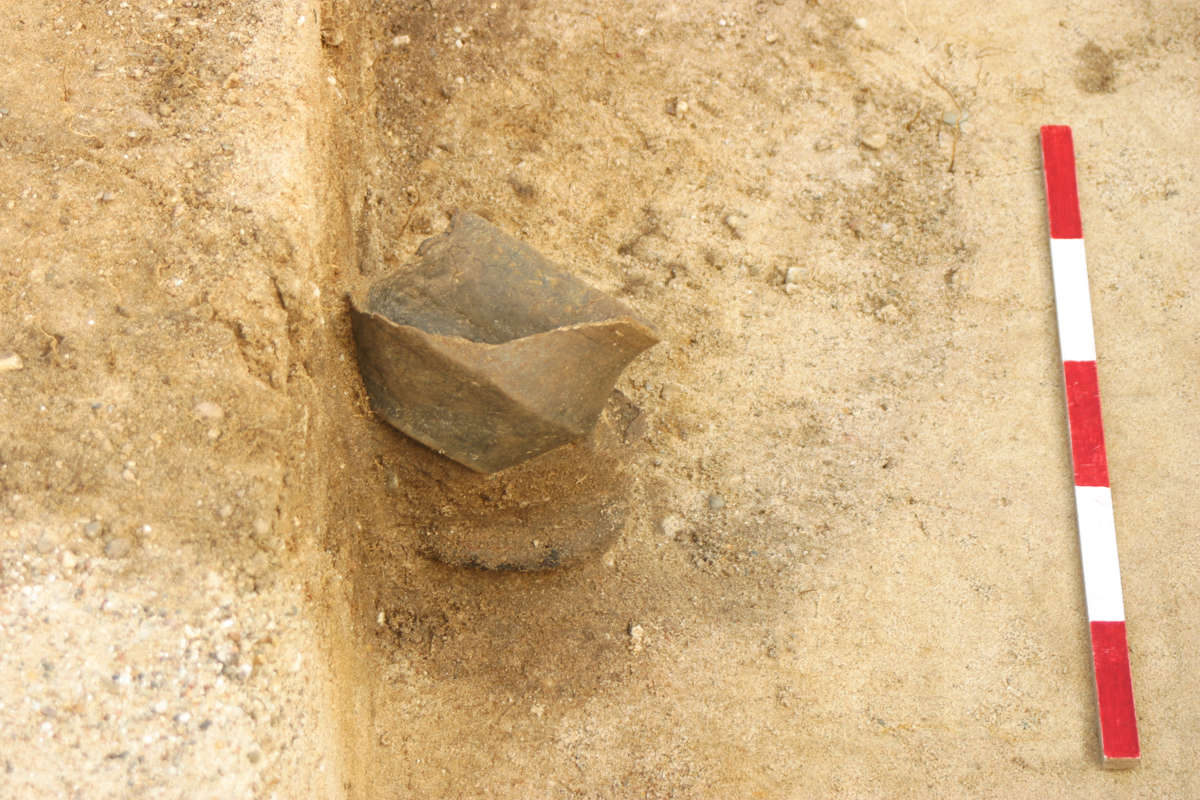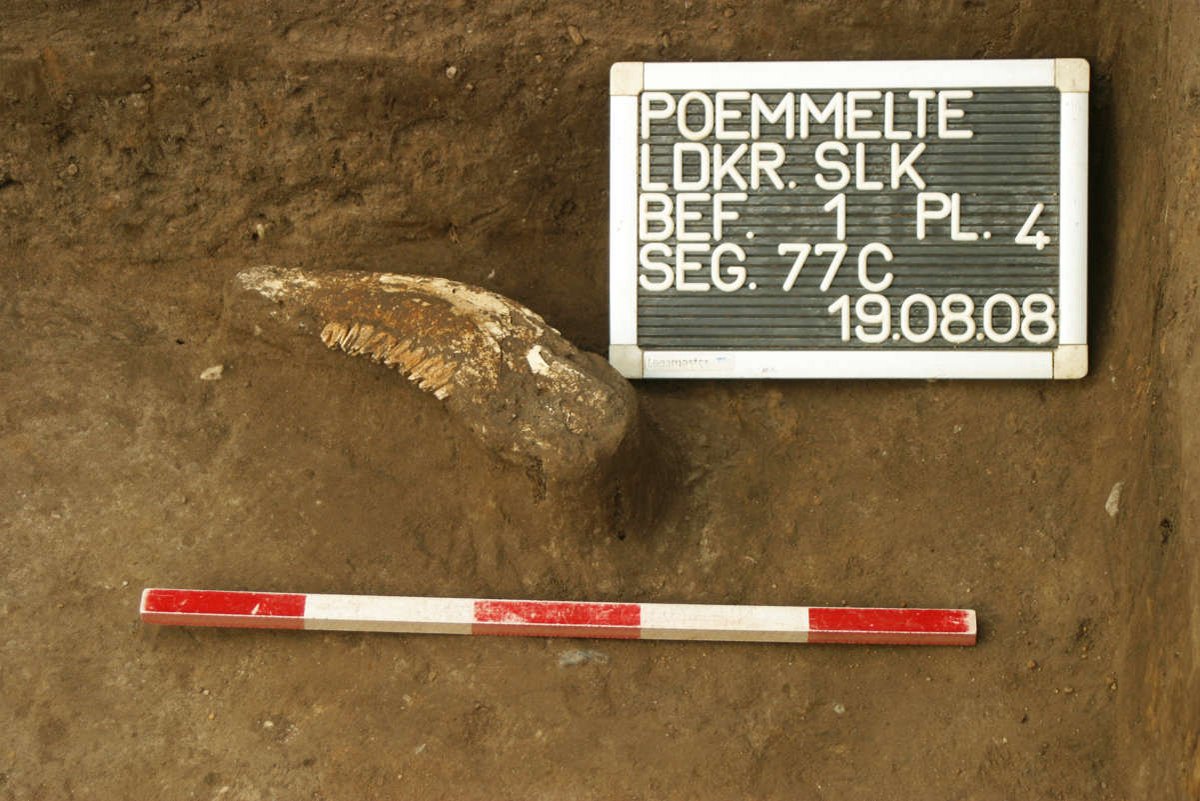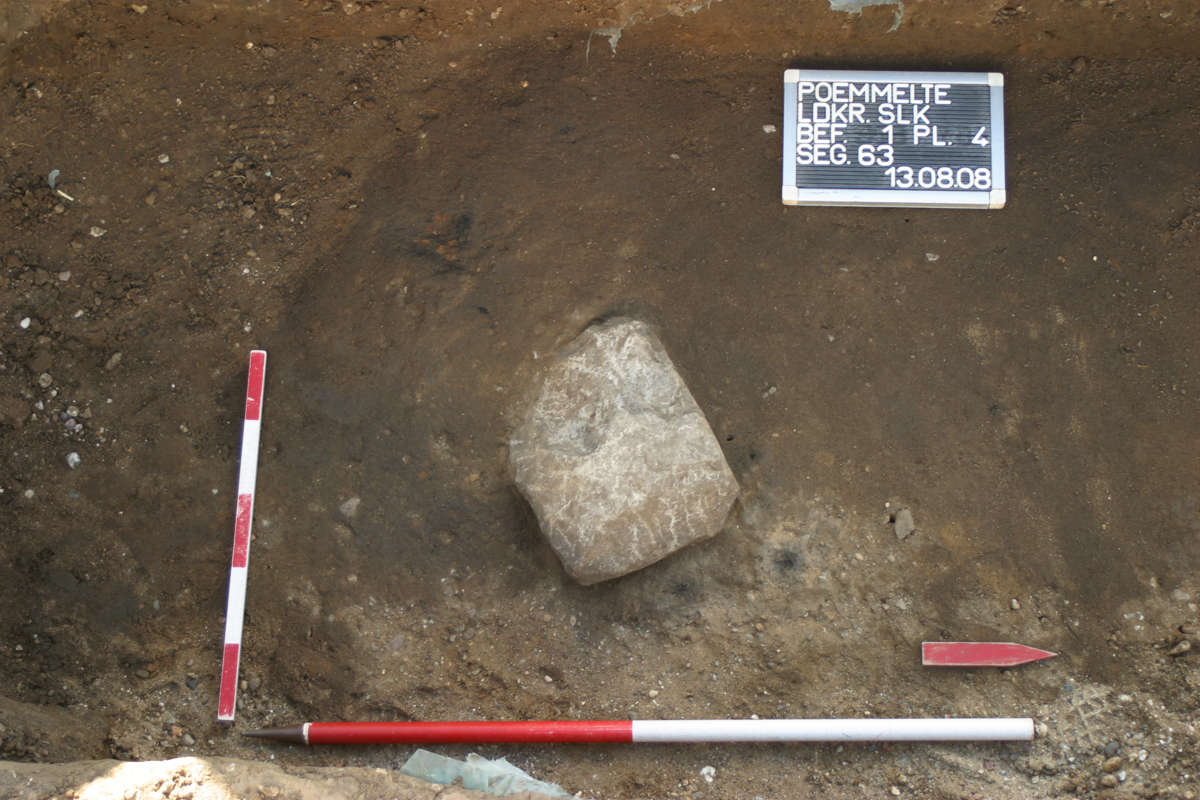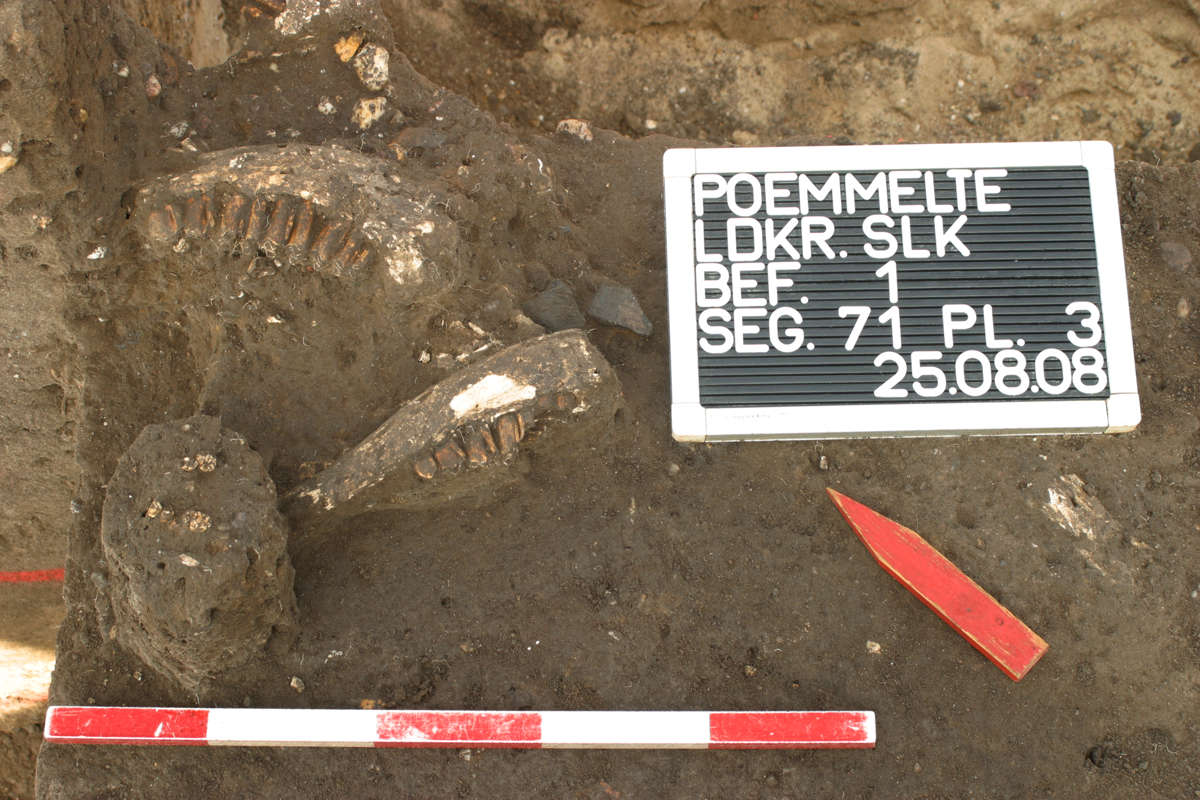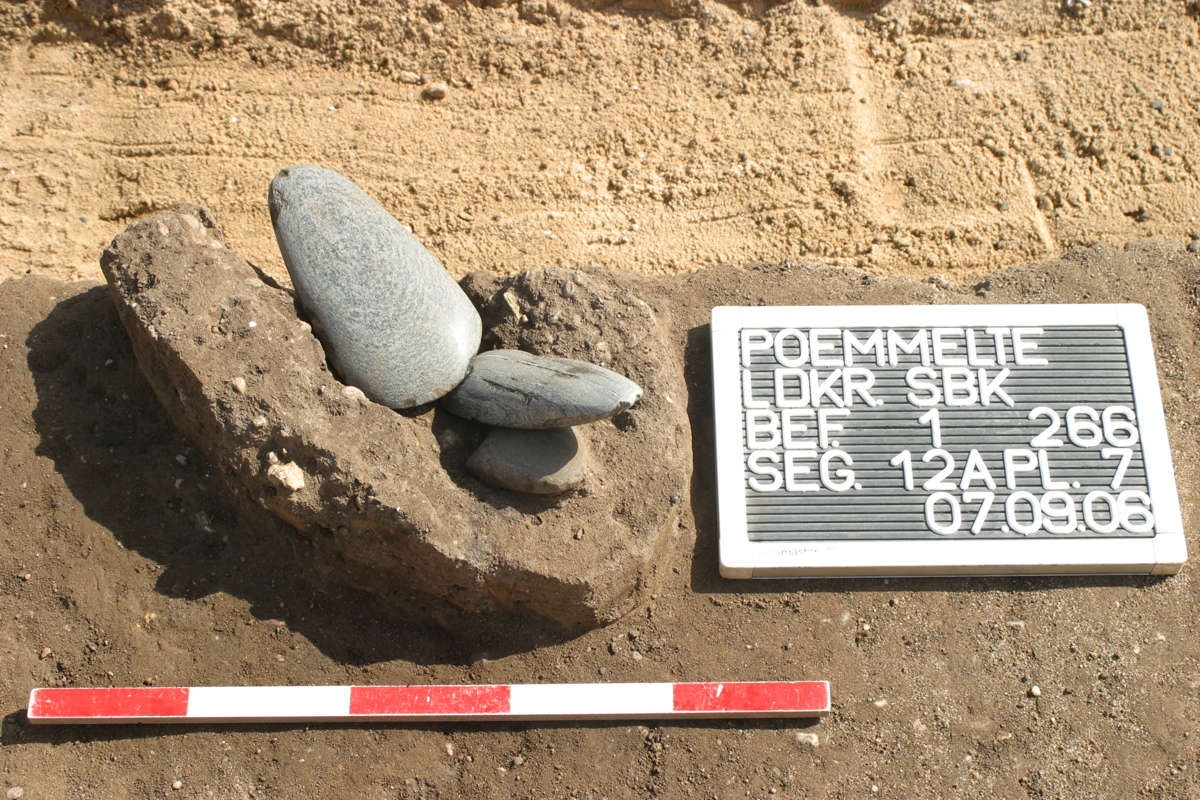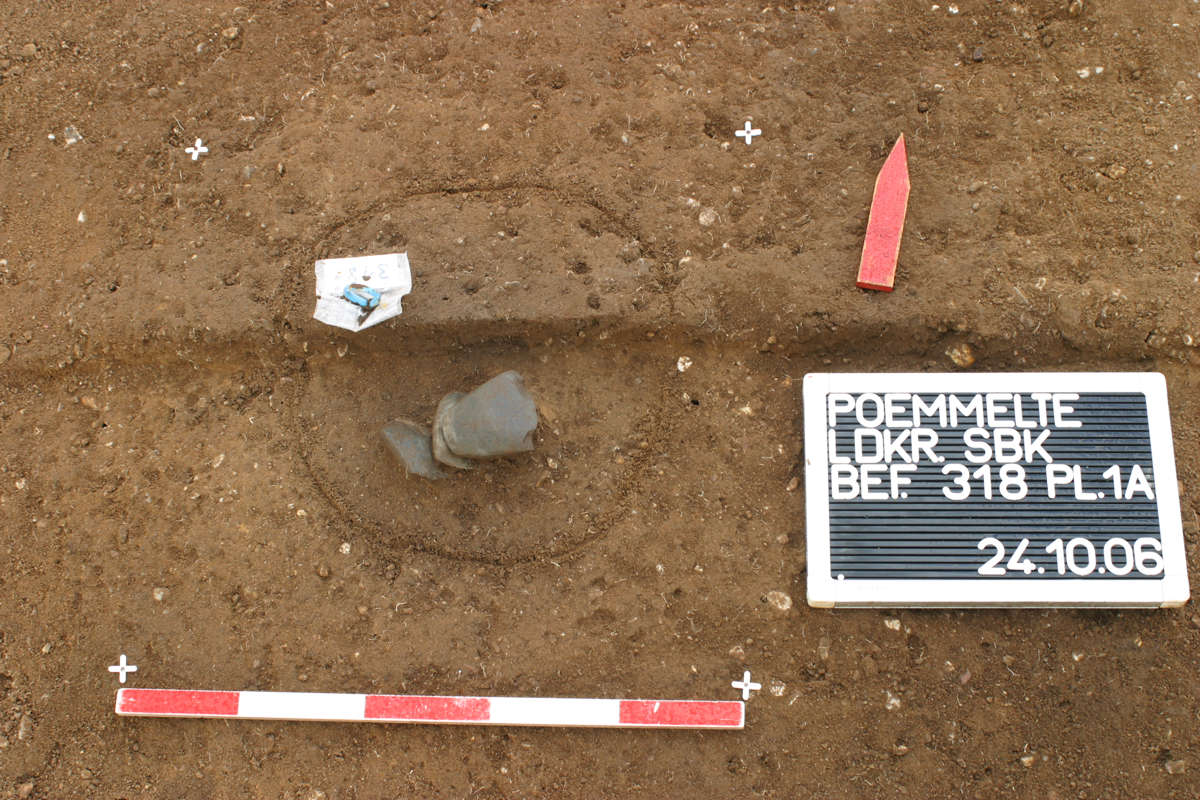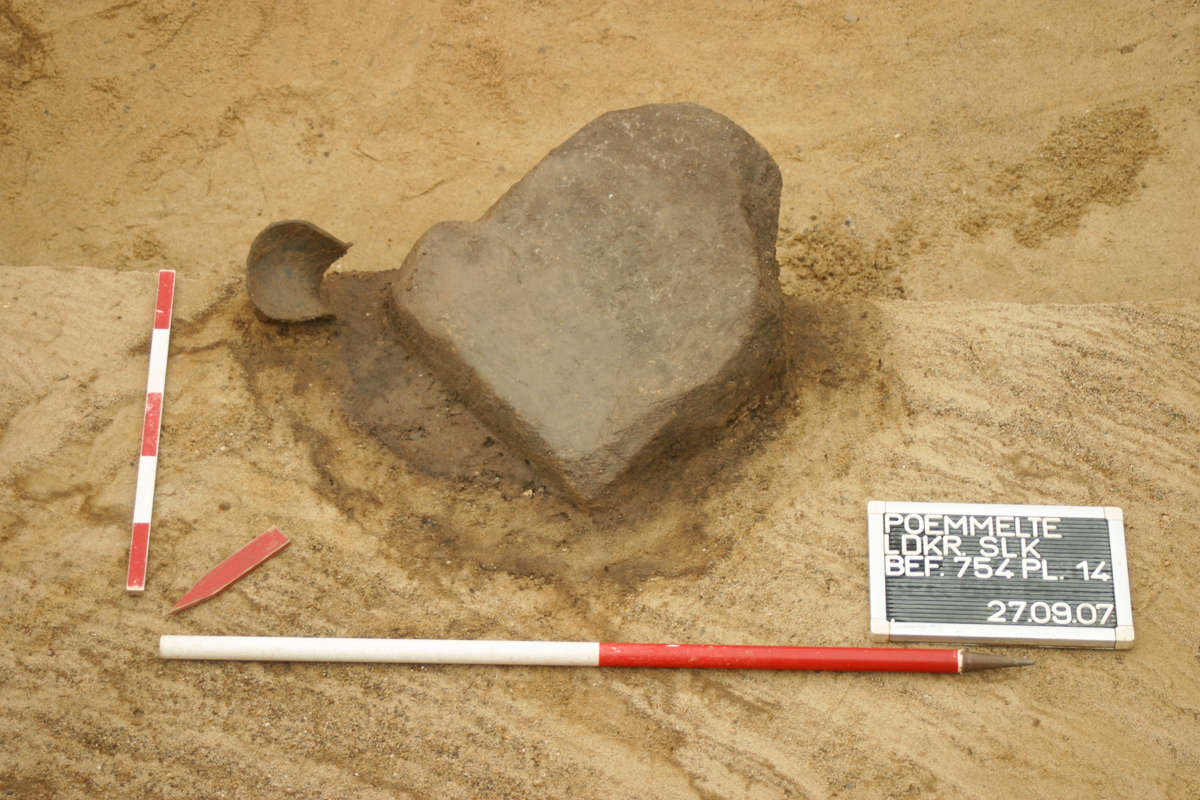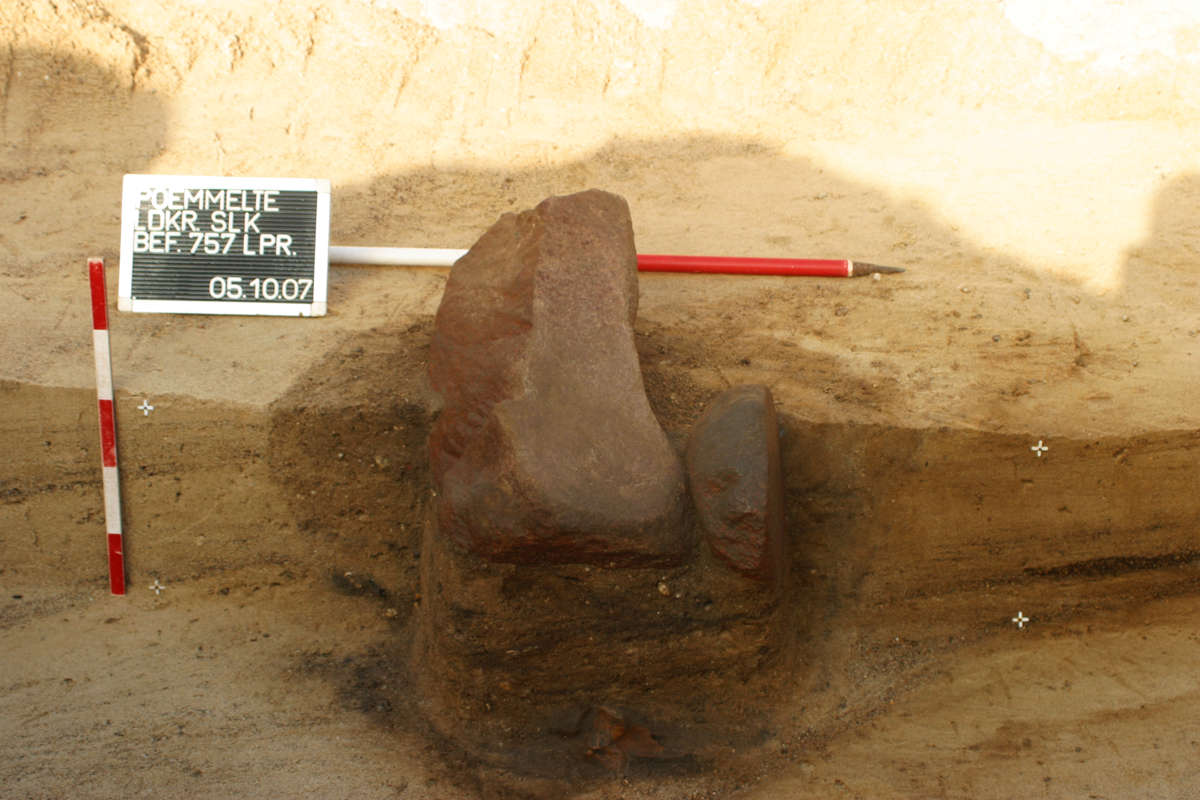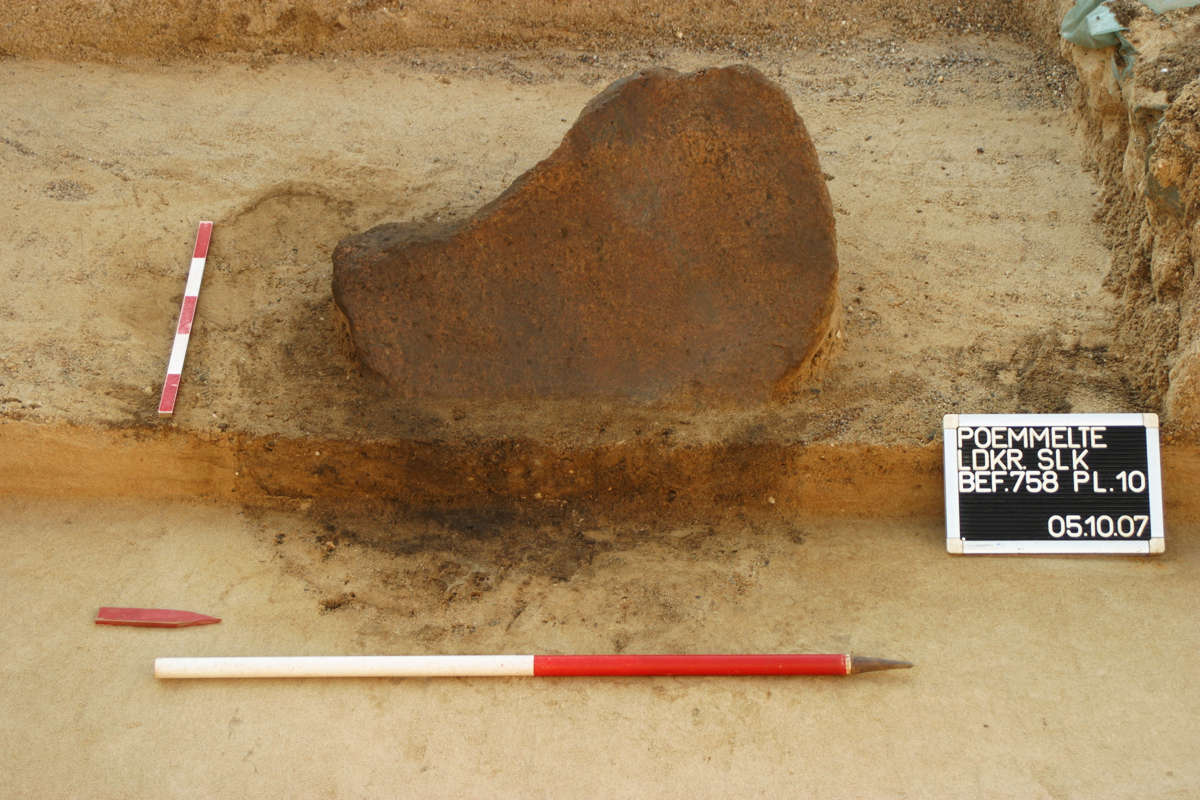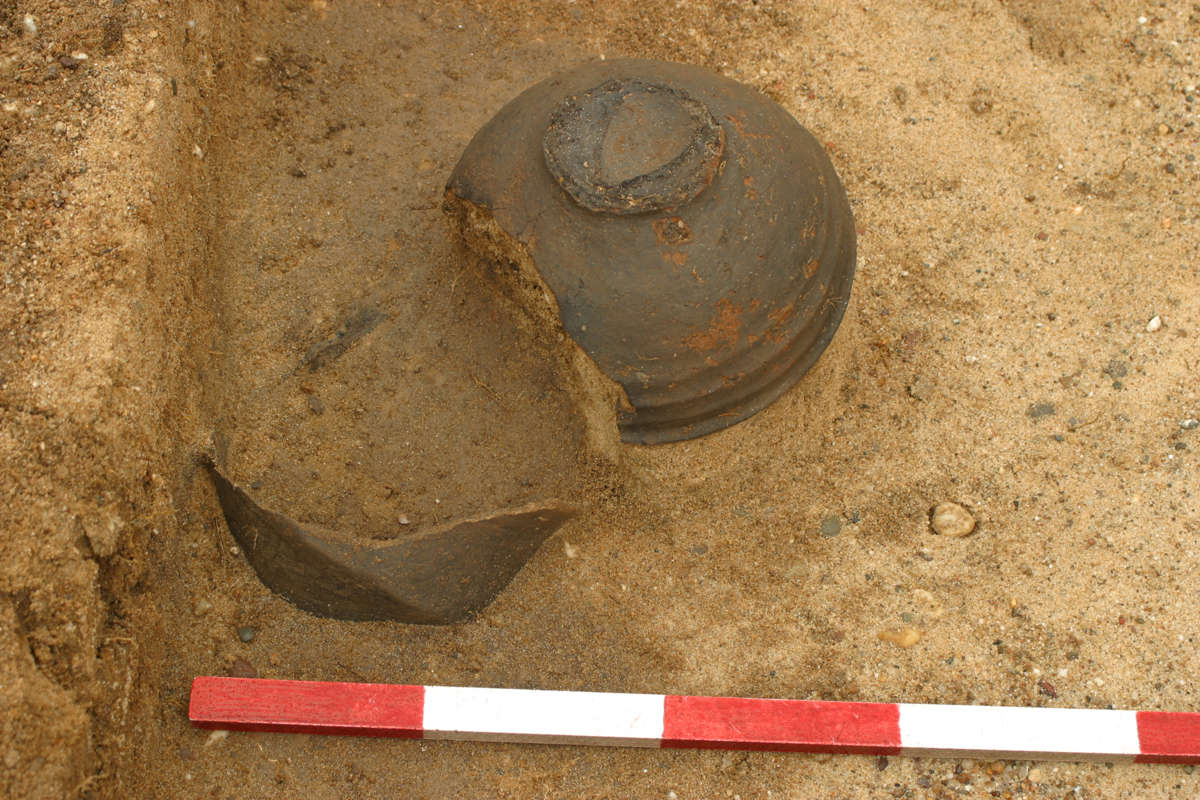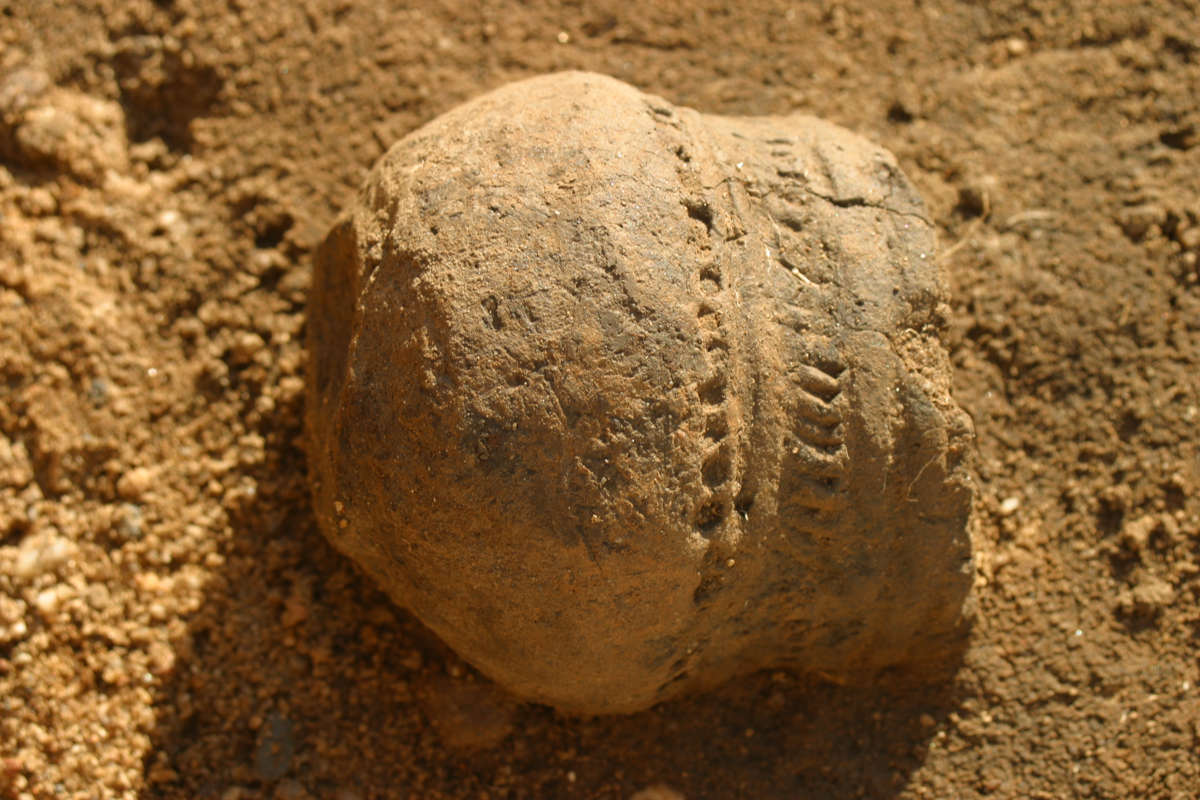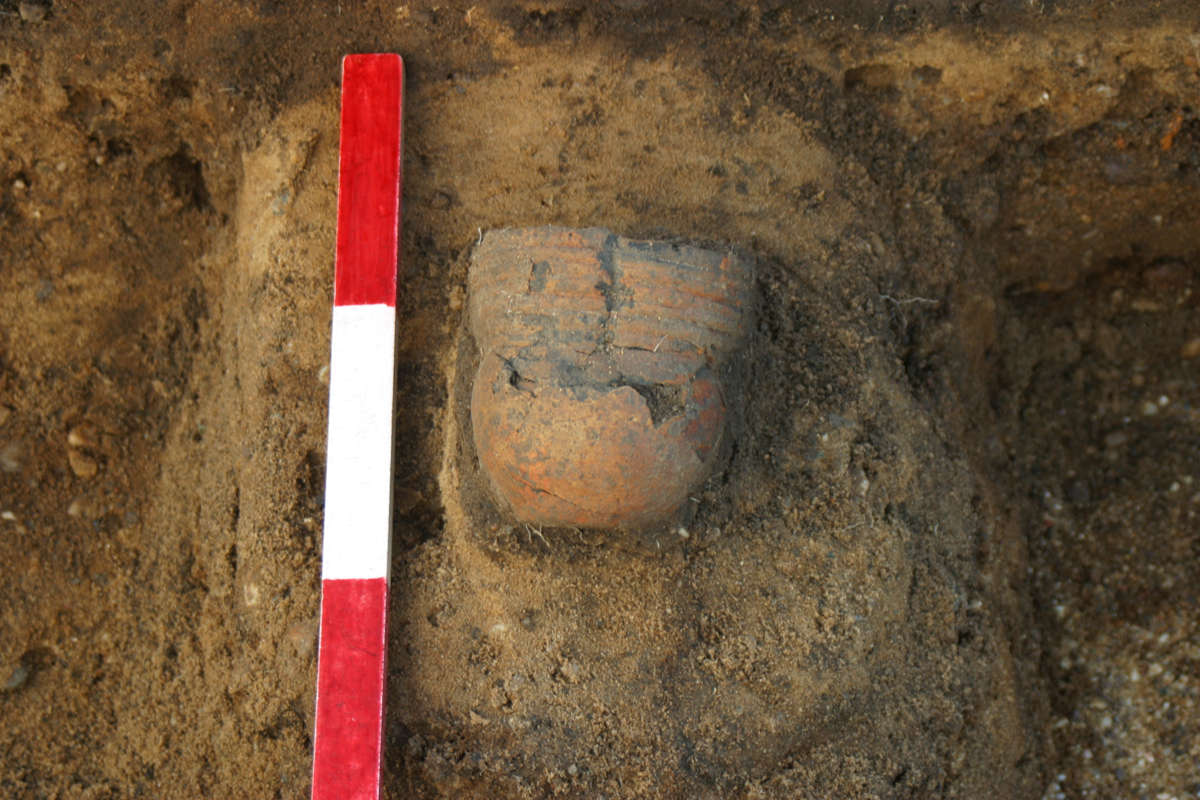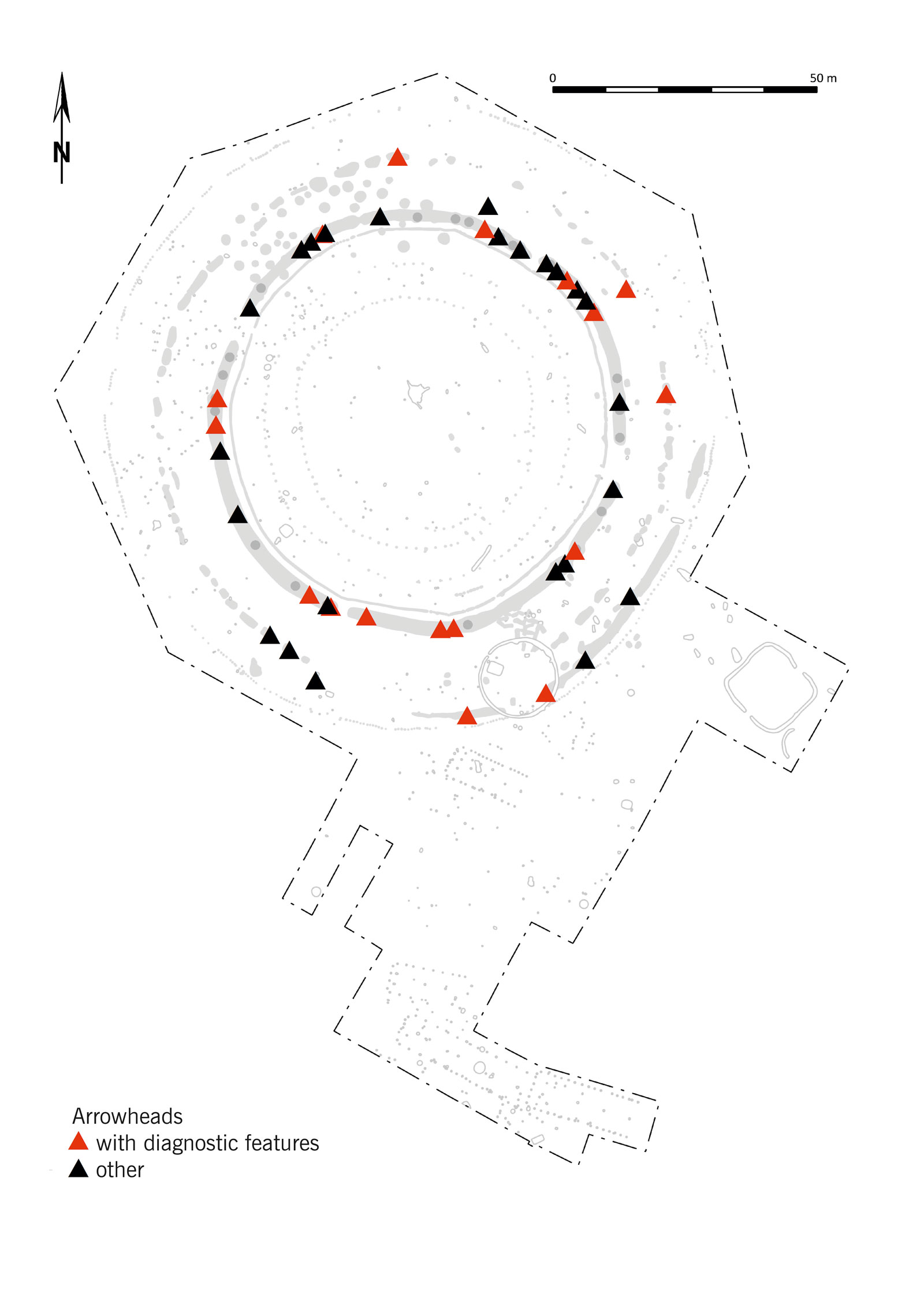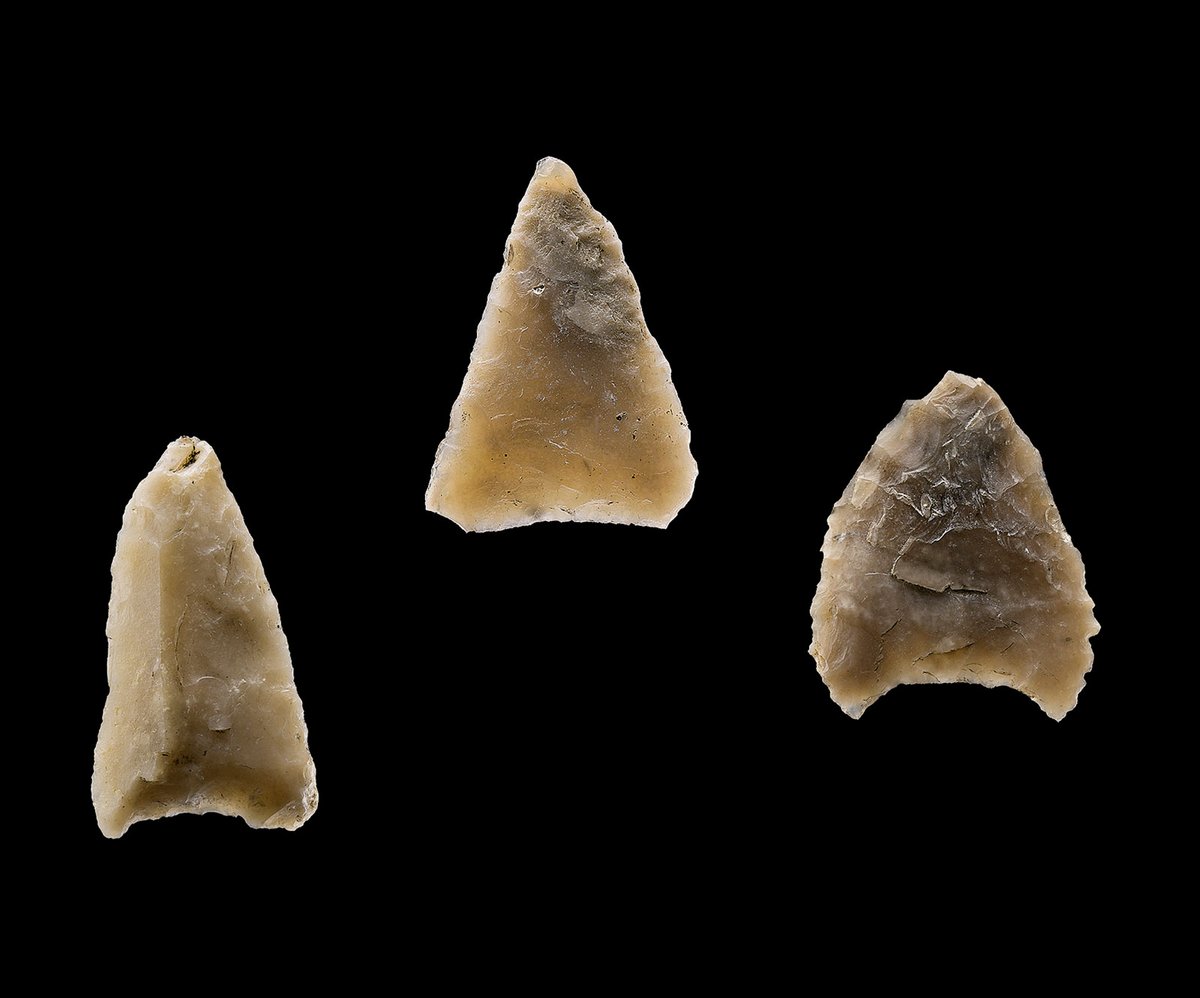The roundel at Pömmelte-Zackmünde (Salzland district) is a monumental structure from the transitional horizon from the Final Neolithic to the Early Bronze Age. The site was discovered in 1991 through aerial archaeological prospection and was completely excavated in several excavation campaigns from 2006 to 2008 as part of a cooperation project between the State Office for Heritage Management and Archaeology Saxony-Anhalt and the Institute for Art History and Archaeologies of Europe at the Martin Luther University Halle-Wittenberg.
The chronology and construction show similarities above all with the henge monuments on the British Isles. However, the 29 shaft pits, which show clear traces of ritual acts, are so far unique.
The Pömmelte-Zackmünde roundel consists of a complex architectural system of several concentric rings of ditches, palisades, pits, and an earthen bank. The enclosure has a total diameter of 115 m and can be divided into an inner and outer area:
The inner area consists of a largely continuous palisade (V, dark green) and two loosely spaced inner rings of posts (VI red and VII orange). This area is enclosed by a circular ditch (IV, light green) with 29 shaft pits (yellow), in front of which was probably a low earthen bank. This is followed from the inside outwards by a segmented ditch (III dark blue), a ring ditch segment (II grey) restricted to the south-eastern quadrant, and the outer ring of posts (I black).
The concentric rings of posts and ditches have passages (A/A', B, C) at different positions corresponding to the points of sunrise and sunset at special astronomical events.
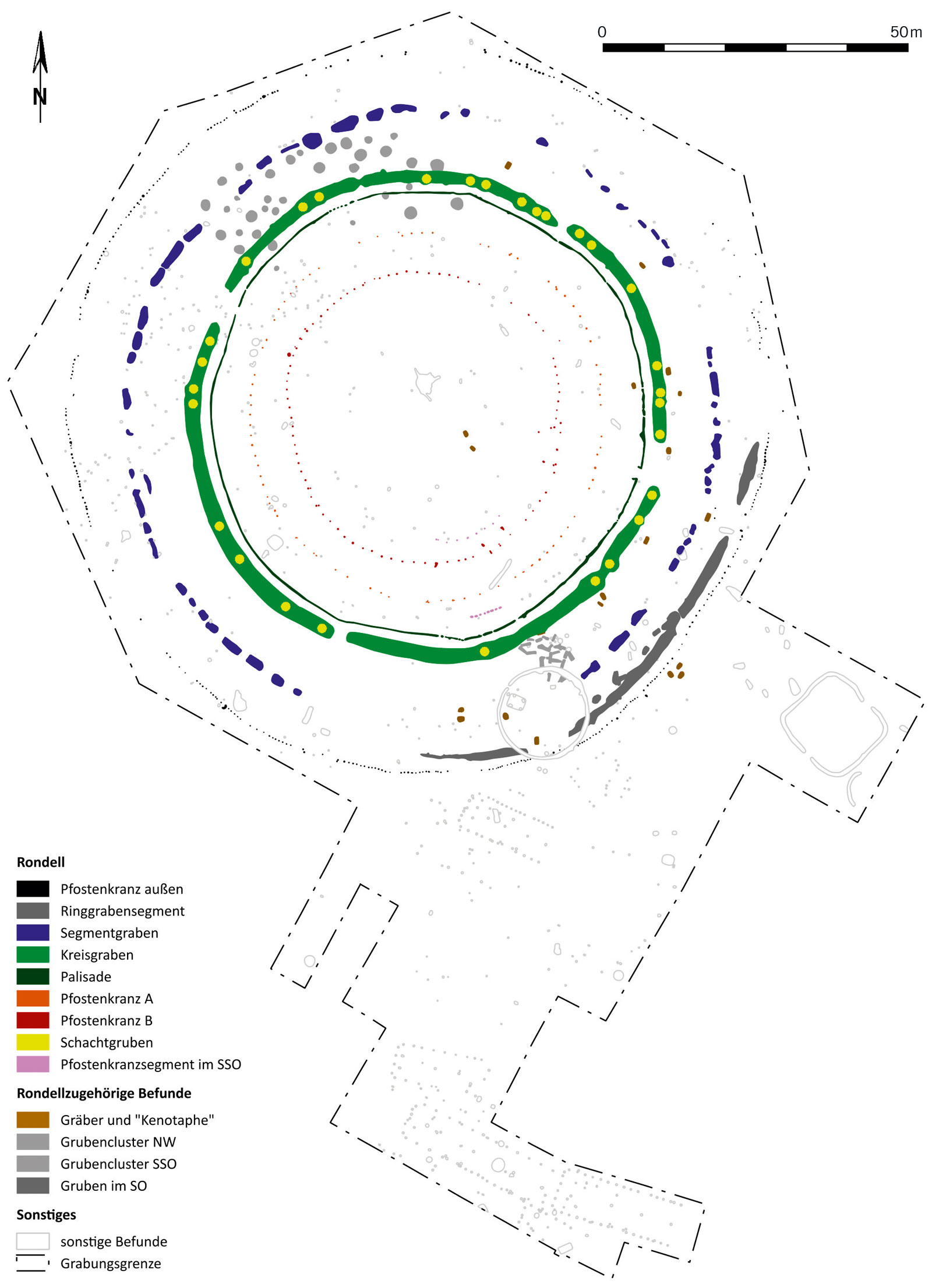
Square ditch of the Corded Ware, feature Befund 1022
The approximately square ditch structure of c. 14 x 16.65 m dates to the older phase of the Corded Ware Single Grave complex (first half of the 3rd millennium BC). It was therefore built long before the construction of the circular ditched enclosure. The two interruptions in the north-east and south-west face each other and show astronomical references to the rising and setting points of summer and winter solstices.
SA SSW: sunrise summer solstice, SU WSW: sunset winter solstice.
Apart from the ditch, no other features, such as traces of posts, were discovered that could provide clues to a possible superstructure. A comparable feature was not only recorded at the nearby circular ditched enclosure of Belleben (Salzland district), but also at the neighbouring site in Schönebeck in 2021, at exactly the same place as in Pömmelte! It is possible that this is an at least regional pattern, in which circular ditched enclosures were deliberately aligned with a very specific spatial reference to an older monument.
Functional interpretation
Due to the astronomical orientation of the structure and its proximity to the circular ditched enclosure, the square ditch is interpreted as a sacred monument. A further indication of this are finds of short-wave moulded “Wellenleisten” vessels, which sometimes also come from feature contexts that make a non-profane interpretation very likely. An example of this is a vessel deposition of a large short-wave moulded pot in a rock crevice on the highest point of Bacín Hill (Beroun district, Czech Republic).
Corded Ware mortuary chamber, feature Befund 575
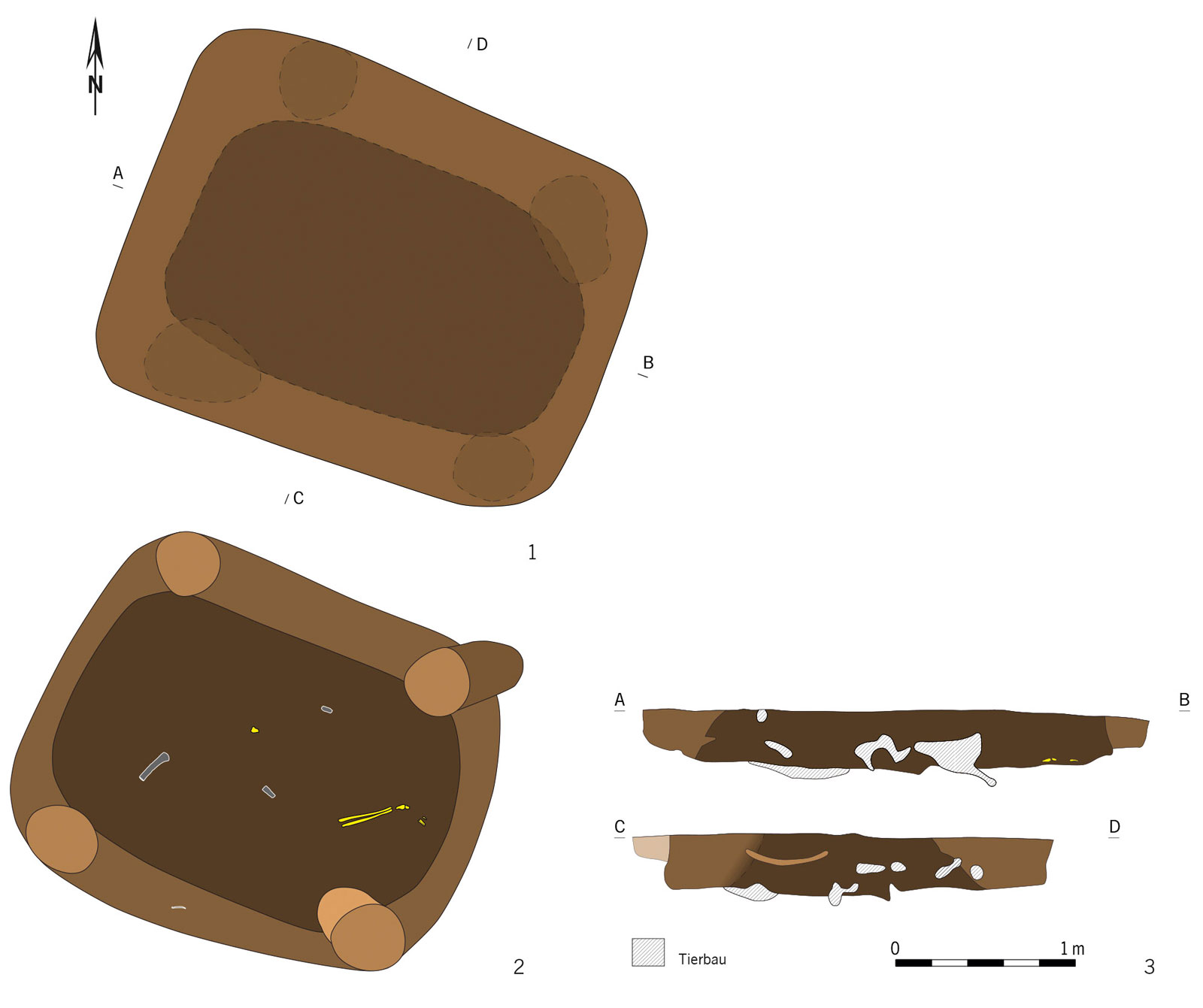
In the southern area of the site, between the outer palisade ring, pit clusters (dark grey) and the segmented ditch (dark blue), a burial feature from the Corded Ware period came to light. It is a rectangular discolouration measuring about 2.80 x 2.20 m with a post at each corner. The feature is interpreted as a wooden burial chamber.
The burial
Within the feature, the excavators found the lower leg and foot bones of a man of adult (20 to 39 years) to mature (40 to 59 years) age. The other bones were not preserved. The position of the bones suggests a burial in a crouched position on its right side. The funerary practice and orientation of the body to west-north-west and east-south-east correspond to the typical burial custom of the Corded Ware Culture.
The deceased was buried with two flint blades, an A-axe (perforated stone axe) and a flint axe. The finds also correspond to the common pattern of grave goods of an outstanding male burial of the Corded Ware Culture.
At the time of the construction of the circular ditched enclosure, the grave was probably still mounded over and therefore visible above ground. This is indicated by the interruption of the ring ditch segment at this point. Apparently, the builders of the circular ditched enclosure consciously respected this older grave monument and integrated it into the overall architectural concept.
The south-east passage
The largely solid screening palisade has in three places interruptions or loosely set posts, which allowed a view to the outside. However, the two passages to the south-east (ESE) and north-west (WNW) are the only ones that correspond with an interruption in the ring ditch. They are therefore interpreted as the main access points or main visual axes.
The gate jambs of the palisade
Similar to Goseck, the south-eastern palisade opening has gate jambs turned towards the interior of the enclosure. At 1.55 m, the opening was somewhat wider than the one in the north-west. One or two people could pass through at the same time.
Astronomical sight lines
The passages were aligned with certain astronomical events in the calendar year. In the area of the south-eastern palisade opening, it was possible from the assumed centre of the complex to observe the rising of the sun around 24 February and 18 October. Unlike in Goseck, these two dates are not solstice dates, but can rather be assigned to the mid-quarter year festivals. They mark the beginning of spring and autumn, respectively, and thus important events in the farming year. The sun remains In the area of the main passages for three to four days, so that an assignation to a precise day is not possible.
The north-western passage
The north-western (WNW) passage is axisymmetrically opposite the one in the south-east. It differs from its south-eastern counterpart by a slightly less width of 1.30 m and by the absence of gate jambs.
Astronomical references
In the late 3rd millennium BC, sunset was observable from the centre of the complex around 7th May and 8th August. These dates are most likely to be associated with Beltane, the festival of the beginning of summer or May Day, and Lughnasadh, the festival of the beginning of harvest in August.
Shaft pit, feature Befund 1099
Circular in plan, U-shaped profile; width (at ditch floor): 0.90 m, width (at pit floor): 0.90 m, depth: 1.80 m
The shaft pit contained two deviant burials: a child aged 5–7 and a woman about 30 to 40 years old. Both skeletons lay on the pit floor and exhibited perimortem traumata to the skull and thorax. The child's skeleton lay directly above the woman's skeleton, which was found in a prone position with a bent upper body. The child's legs were strongly angled and folded to the side in a riding position.
Between the two individuals were found bones of sheep and cattle. Above the corpses had been deposited an almost completely preserved bell beaker and a handled vessel with its mouth pointing downwards.
Shaft pit, feature Befund 1101
Circular in plan, U-shaped profile; width (at ditch floor): 1.15 m, width (at pit floor): 0.70 m, depth: 1.90 m
The shaft pit was sunk almost vertically into the already partially filled ditch (phase III). At the level of planum 10 the skeletons of a 10 to 14 year old child and a 15 to 17 year old young woman were discovered. The child's skeleton was missing both legs. The pelvis was unnaturally bent backwards. The female individual was missing all extremities, only the skull and torso were found in anatomical association. Her skull was severely tilted backwards and showed several fractures. Further perimortem trauma was discovered in the thoracic region.
In the lower part of the shaft pit, the shape and stratigraphy of the infill allow the reconstruction of a container that had not been preserved. Directly above the bottom of the container, the excavators found a small stone axe. Other finds came from the infill. These are animal bones, pottery sherds and an almost complete bowl-like beaker.
Shaft pit, feature Befund 300
Circular in plan, U-shaped profile; width (at ditch floor): 1.60 m; width (at pit floor): 0.90 m, depth: 2.25 m
Deviant burial of a child
The shaft pit reveals a stepped profile and several infill horizons. In the lower part of the pit, the shape of the feature and the infill indicate a cylindrical, organic container, which, however, had completely decayed by the time of excavation. In it lay the skeleton of a 2 to 4 year old child in foetal position resp. in a crouched position on its right side. Parts of the left lower leg, the left forearm and the right arm were missing. Whether these skeletal parts were only missing due to preservation conditions or whether they had been removed premortem cannot be clarified with certainty. The fragility of children's skeletons speaks for a preservation-related absence. Other shaft pits, on the other hand, contain skeletons and bones that clearly show signs of violence.
A ritual sealing of the pit?
The shaft pit contained fragments of pottery and animal bones in all infill horizons. On the surface of the lowest infill horizon three small stone axes, one arrowhead, and a fragment of a human femur were deposited. The latter belonged to an adult male. A radiocarbon date was obtained from a cattle bone in the uppermost infill layer, dating the infilling to 3828 ± 28 before present, i.e. around 1800 BC.
Outer circle of posts
The outermost structure of the circular ditched enclosure is a ring of single posts, more or less evenly spaced. During the excavations, 318 post pits were recorded. However, due to the poor preservation of the features and the shallow depth preserved, the total number is estimated to originally have been between 400 and 500.
In the course of the outer ring of posts, some features are recognisable that deviate from the regular post settings. They apparently relate to an axis starting from the centre of the roundel and emphasised certain areas of the ring structure.
II Ring ditch segment with pits
In the south-east of the complex, a crescent-shaped ditch runs between the outer ring of posts and the segmented ditch. It consists of four sections and extends over an arc of about 83 m in length. The 1.20 to 2.00 m wide ditch has a shallow, flat bottomed cross-section and was only preserved to a depth of 14 to 26 cm deep in section. Two openings are observable: a 5.40 m wide opening on the south-west-south main access axis of the roundel and a 7 m wide opening in the area of the Corded Ware burial mound (feature Befund 575). The feature appears to respect the older burial site.
Segmented ditch
Between the outer ring of posts and the circular ditch runs a ring of 54 closely-set pits. They were infilled with humic earthen material and contained some charcoal inclusions and in some cases also charcoal-bearing lenses as well as daub and burnt clay.
The interruptions of the segmented ditch could be interpreted, at least in some places, as deliberately created openings or passages. This certainly applies to the main axes of the enclosure in the east-south-east and west-north-west. Another conspicuous interruption corresponds with a special post setting of the outer post ring in the south-west. There is also a long section in the south of the circular ditched enclosure where no pits were detectable.
Circular ditch
The circular ditch was divided into 92 segments due to the very loose soil substrates and excavated and recorded by hand in artificial layers according to the cross-section principle. In this way, it was possible to create a continuous longitudinal profile through the entire ditch.
The circular ditch is the largest feature of the complex and most closely approximates a geometrically exact circular shape. Due to minor deviations, the result is an ellipse of 38.30 and 39.40 metres. The max. 2.16 m wide circular ditch was constructed as a flat bottomed ditch. The planum showed conspicuous "bulges" in some places, which could later be identified as shaft pits.
The circular ditch was interrupted in four places and can thus be divided into four ring segments. Two more causeways are located on the two main access axes into the interior of the roundel. The particularly wide openings are located in the east-south-east and west-north-west and correspond with the here observed openings in the other structures of the circular ditched enclosure.
André Spatzier recognised a total of five different sedimentation phases in the stratigraphy of the fills of the circular ditch:
- completely open ditch or only a thin lens of sediment at the bottom of the ditch
- infilling of the ditch due to natural erosion
- partially infilled ditch – consolidation following the deposition of the lower series of layers – „walking horizon“
- extensive infilling of the ditch through deposition of an ash layer and a gravelly layer (ditch spoil from the external bank)
- completely infilled ditch
Palisade
As a feature the palisade appears as a continuous, narrow trench lying concentrically between the circular ditch and the two inner rings of posts. As a building, the structure can be reconstructed as an originally solid screening wall consisting of many individual posts of 15 to 20 cm diameter. The palisade not only visually closed off the interior of the enclosure from the exterior areas of the roundel, the construction also created special acoustics inside. The reflection of the sound waves creates so-called flutter echoes. They create an auditory impression as if one were standing in a large enclosed room and not in the open air.
The two openings in the palisade are aligned with the main access axes of the roundel and allowed one, maximum two, people to pass through at the same time. Furthermore, in the north-west, a loosely spaced post setting (passage C according to W. Schlosser) was also detected, which makes at least a certain optical permeability at this point probable. A clear reference to an astronomical phenomenon could not be established at this location.
Post circle A
The larger of the two inner circles of posts runs about 6.00 to 6.70 m from the palisade. It consists of loosely spaced single posts set in regular intervals. Similar to the circular ditch, Post Circle A also circumscribes an almost circular shape. In four areas deliberately designed interruptions can be discerned: In the east-south-east, opposite the main entrance to the enclosure, a ring segment of six posts is architecturally segregated by gaps in the post circle. In the opposite west-north-west entrance, the post setting is provided with an opening about 3 m wide. Two further gaps are aligned with the narrow causeways of the circular ditch.
Post ring B
The innermost ring of posts also consists of regularly placed single posts and clearly deviates from the ideal circular form. The conditions for features were favourable here, so that all 99 post pits were recognisable, thus the original situation could be precisely reconstructed. On average, there was 1.35 to 1.80 m between the individual posts. The innermost ring of posts has conspicuous post positions in at least six areas, two of which correspond to the main access axes of the complex in the east-south-east and west-north-west.
Shaft pits
So far unique features compared to other roundels are the 29 shaft pits, which were sunk into the circular ditch. The funnel-shaped pits were between 1.50 m and 2.00 m deep, were created at different times and, used over an extended period of 150 to 280 years, repeatedly reopened and refilled. In general, three different infill horizons can be identified:
- In the lower part, the shaft pits sometimes contained deviant burials, primarily of women and children, as well as pottery sherds from drinking vessels, animal bones with butchering marks, and grinding stones.
- In the middle infill horizon were found jaw bones of bovines and grinding stones. Possibly these objects were used to seal the primary deposition. Both infill horizons apparently followed in short succession.
- In the final phase of use of the shaft pits, human skulls and stone axes were deposited near the surface on the most recent infill. In two thirds of the shaft pits, the excavators recorded large quantities of ash, inclusions of charcoal fragments, and fired earthen material in the uppermost fill. These features indicate that after the last infilling of the pits, a fire was lit above them or they were covered with glowing embers.
The depositions in the shaft pits thus follow a certain pattern and can be interpreted as a formalised sequence of ritual actions.
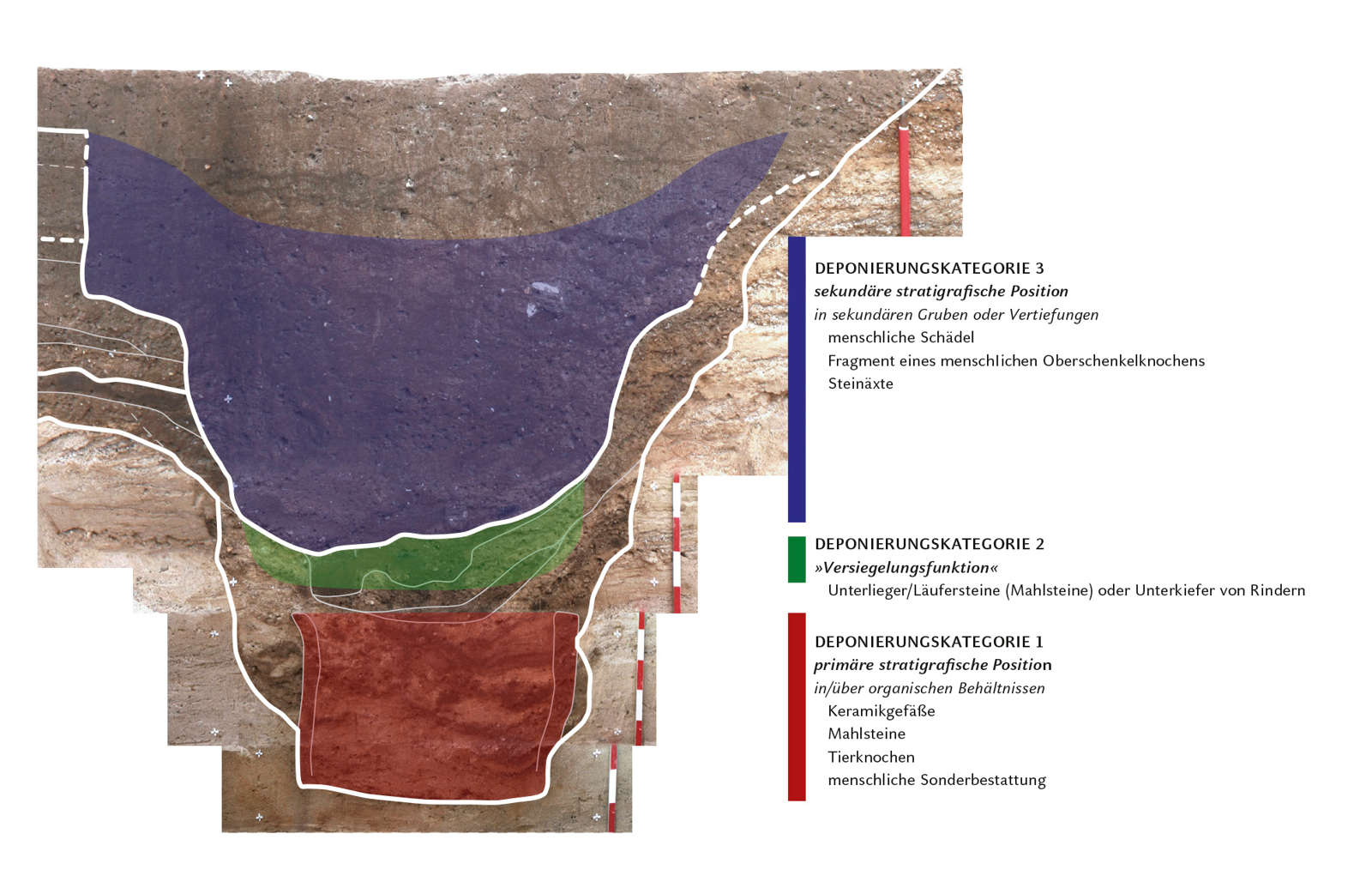
Evidence for containers made of organic material
In 22 shaft pits, the stratigraphy and shape of the infillings indicate organic containers were originally placed in the lower part of the shafts, but have not been preserved due to the soil conditions. They were cylindrical or slightly conical containers made of bast, bark, or wood. In some cases it was found that the shafts were provided with a cover after they had been infilled. The shaft pits were used to receive shattered vessels, animal bones and in some cases human bones. It seems likely that food or food remains such as cereals, fruit, and meat were also deposited. In future, archaeobotanical and archaeozoological investigations will provide detailed insights into the infilling of the shaft pits.
Graves & Cenotaphs
The Pömmelte circular ditched enclosure was a place of the dead. This is shown, among other things, by 13 flat (unmounded) graves of the Bell Beaker and Únětice cultures, which were recorded solely in the eastern half of the site. These are exclusively burials of young adult males. Contrary to the usual burial custom, the dead were not oriented towards the cardinal points but towards the circular ditched enclosure.
The state of preservation of the skeletons was poor, so that often only skulls and long bones were preserved. In some graves, however, evidently only certain parts of the skeletal apparatus were buried.
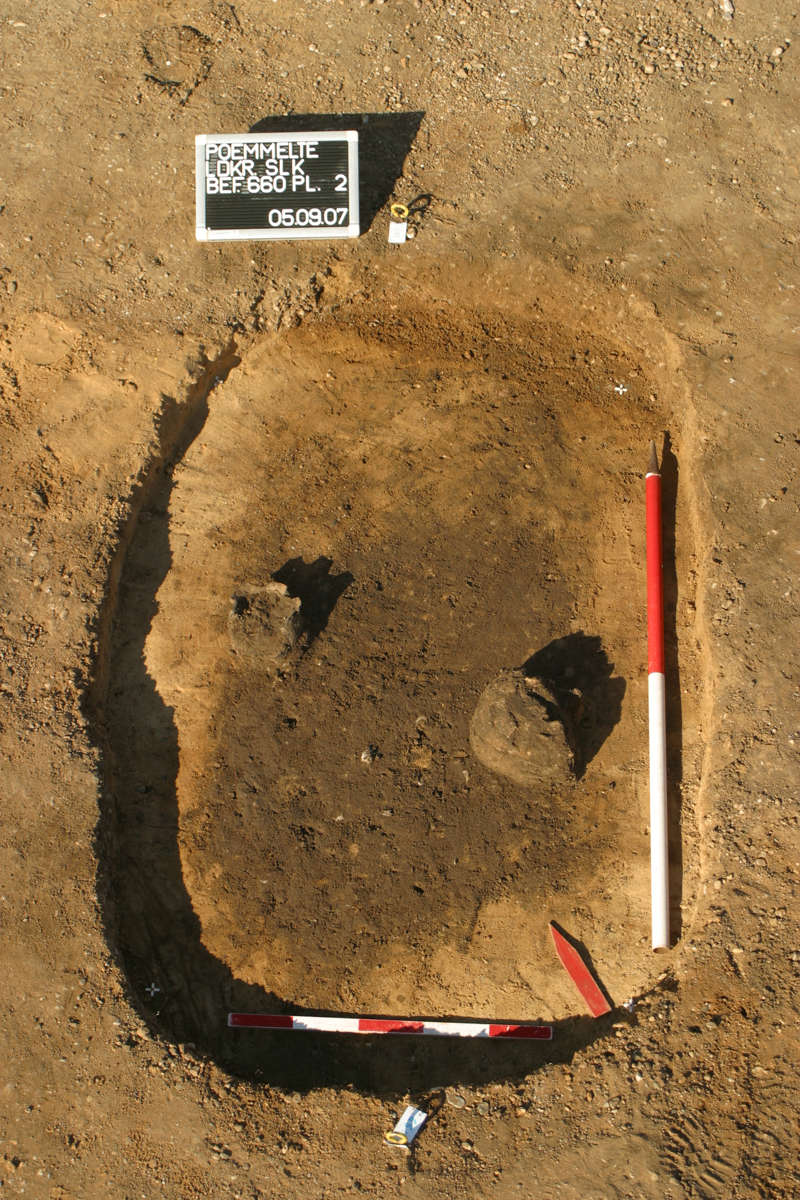
In addition, seven features appeared which corresponded to the flat graves in shape and size but showed no traces of a burial. They are interpreted as cenotaphs. It is probable that they were also connected with the death ritual. The graves were predominantly without grave goods. In some cases, a single ceramic vessel had been placed with the deceased.
* The information is mainly based on the dissertation by André Spatzier:
A. Spatzier, Das endneolithisch-frühbronzezeitliche Rondell von Pömmelte-Zackmünde, Salzlandkreis und das Phänomen des 4.-1. Jt. v.Chr. in Mitteleuropa. Forschungsberichte des Landesmuseums für Vorgeschichte Halle 10/2 vols. (Halle [Saale] 2017).
A total of 55 flint arrowheads were discovered during the excavations of the circular ditched complex. Analyses of the traces of wear and experimental archaeological archery tests suggest that at least 24 of the arrowheads were actually fired and hit a target. In this context, two different hypotheses are discussed:
1. The shooting of arrows in the context of ritual actions, public enactments of warriors.
2. The defence against warlike attacks.
